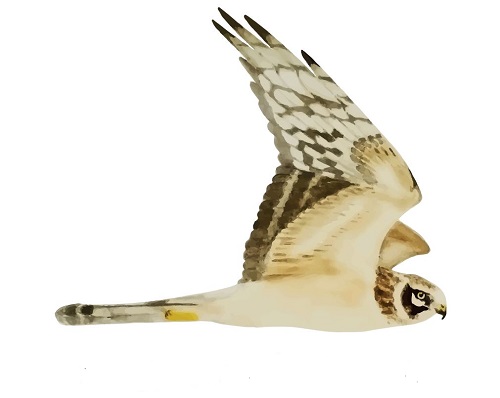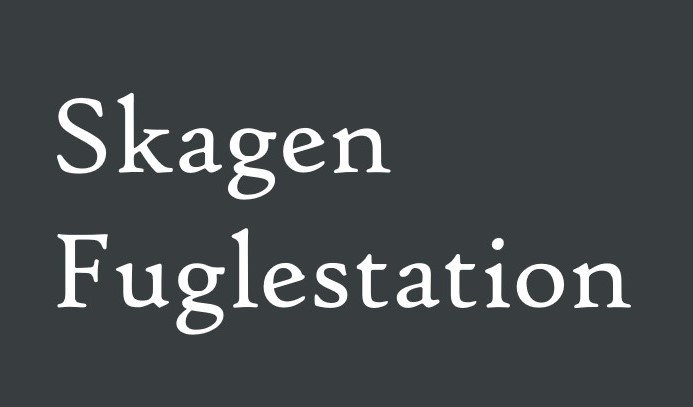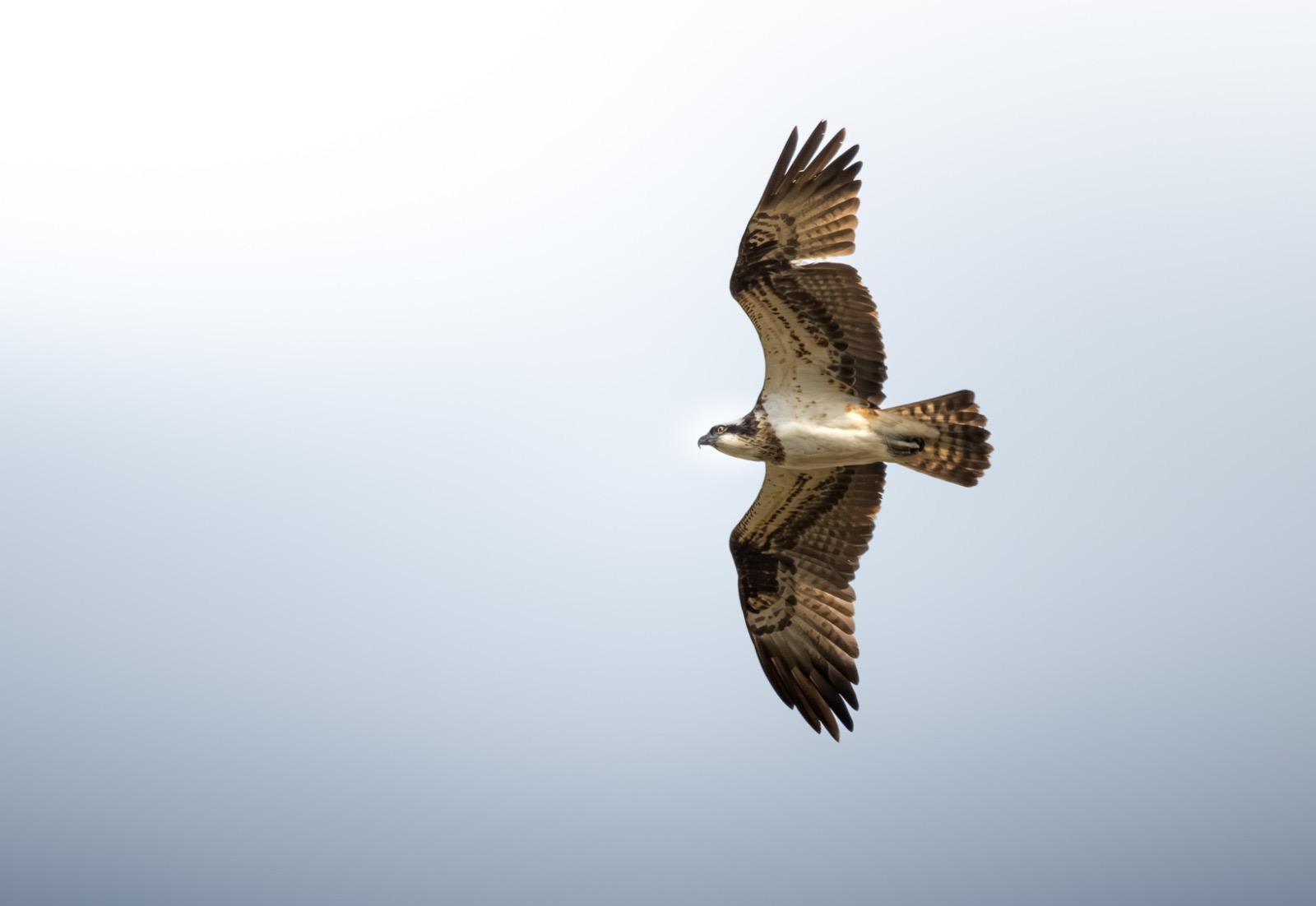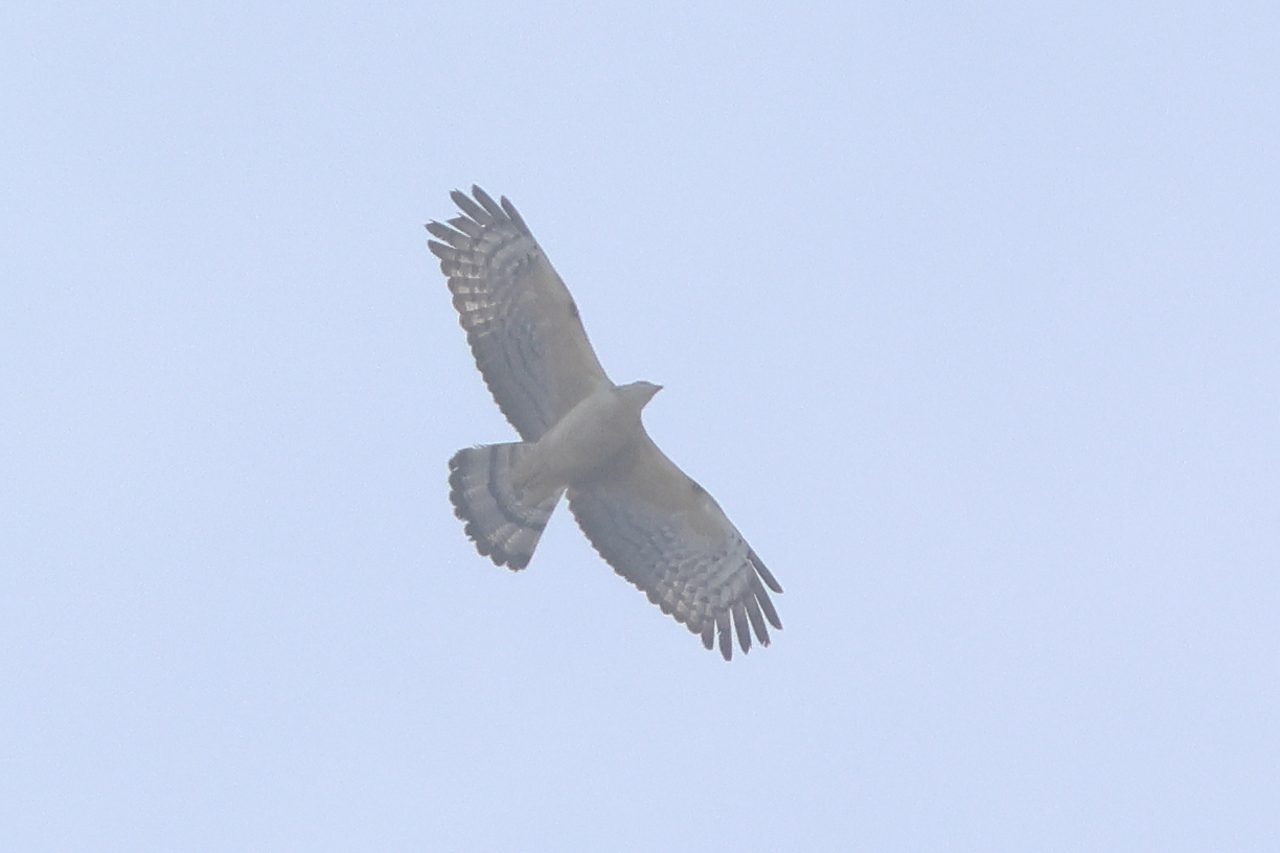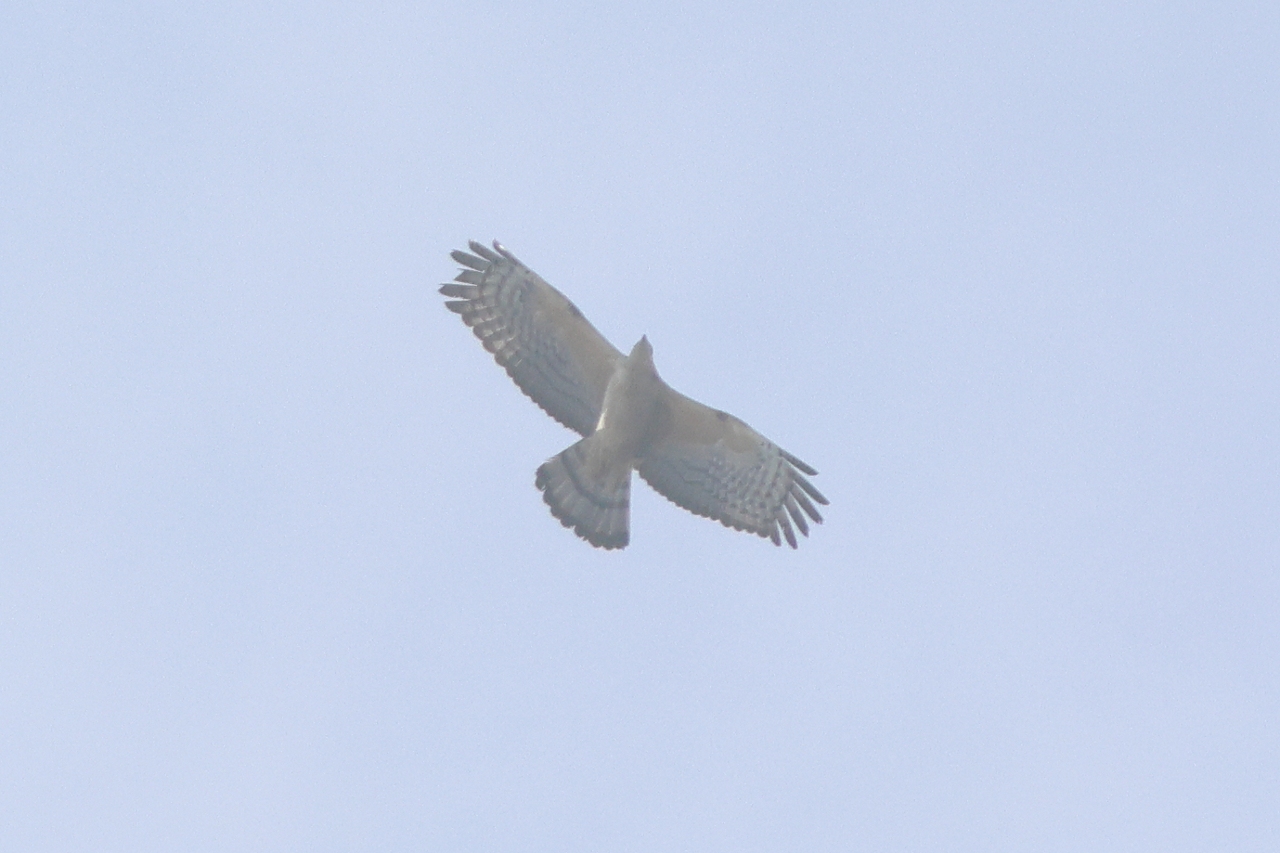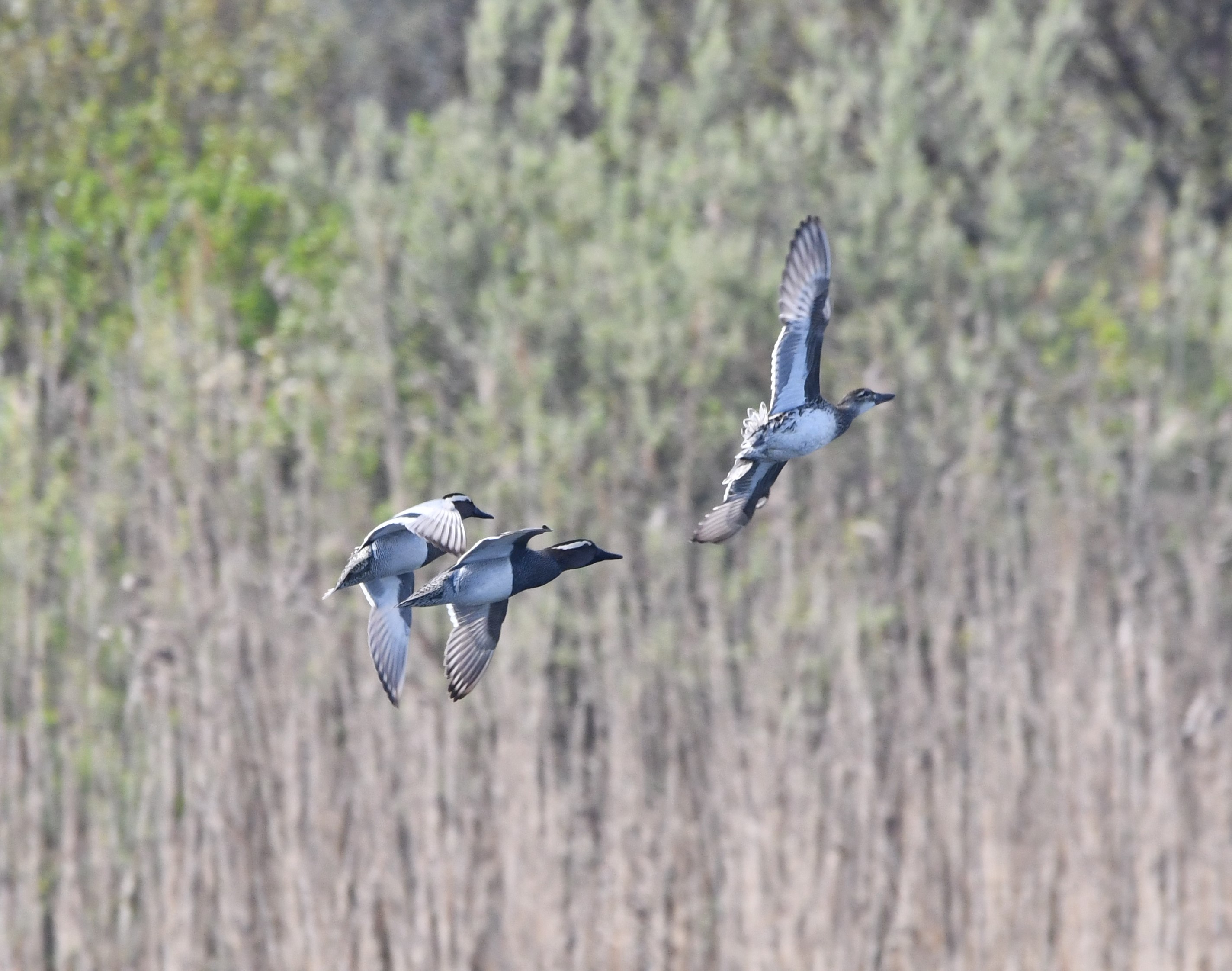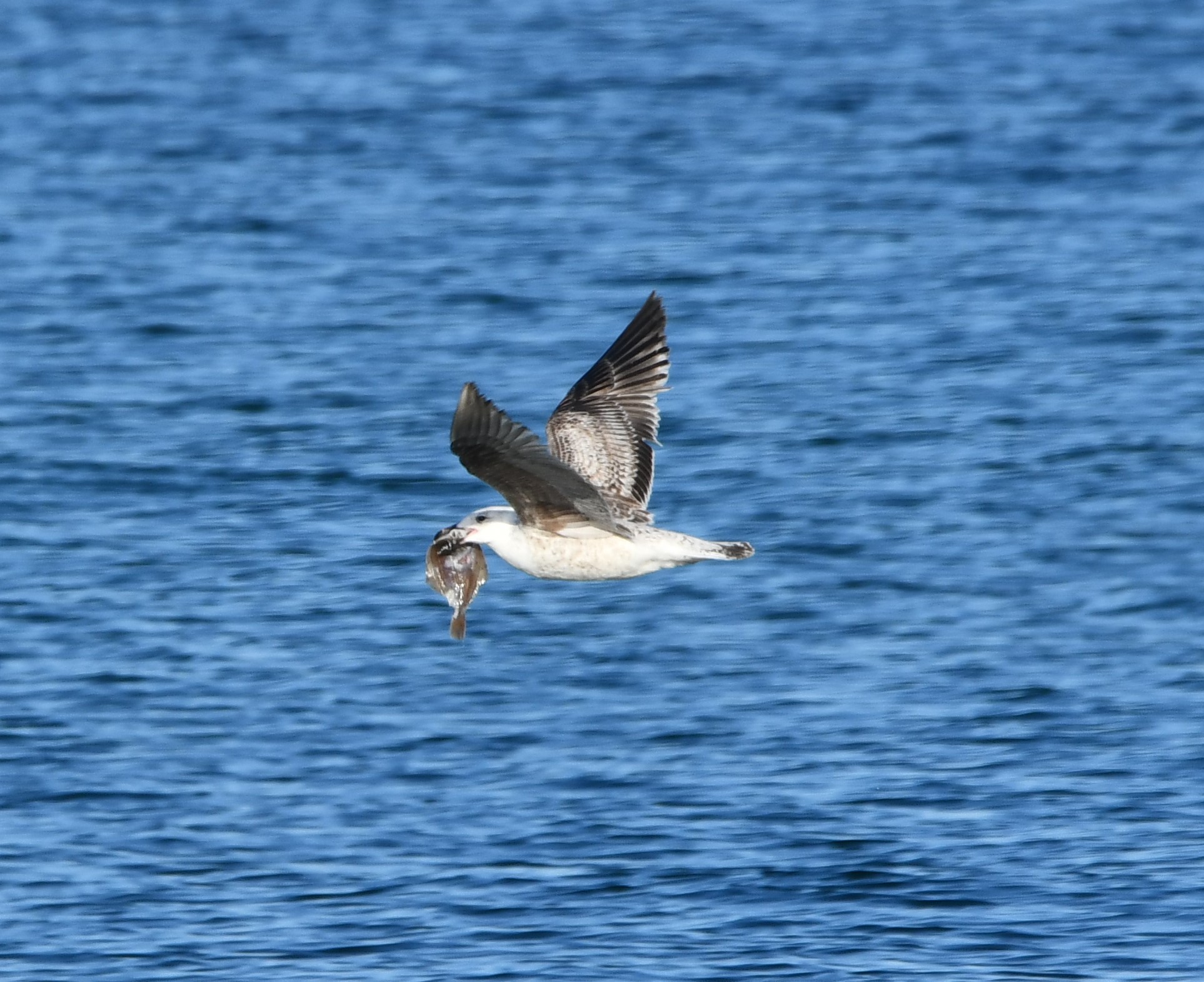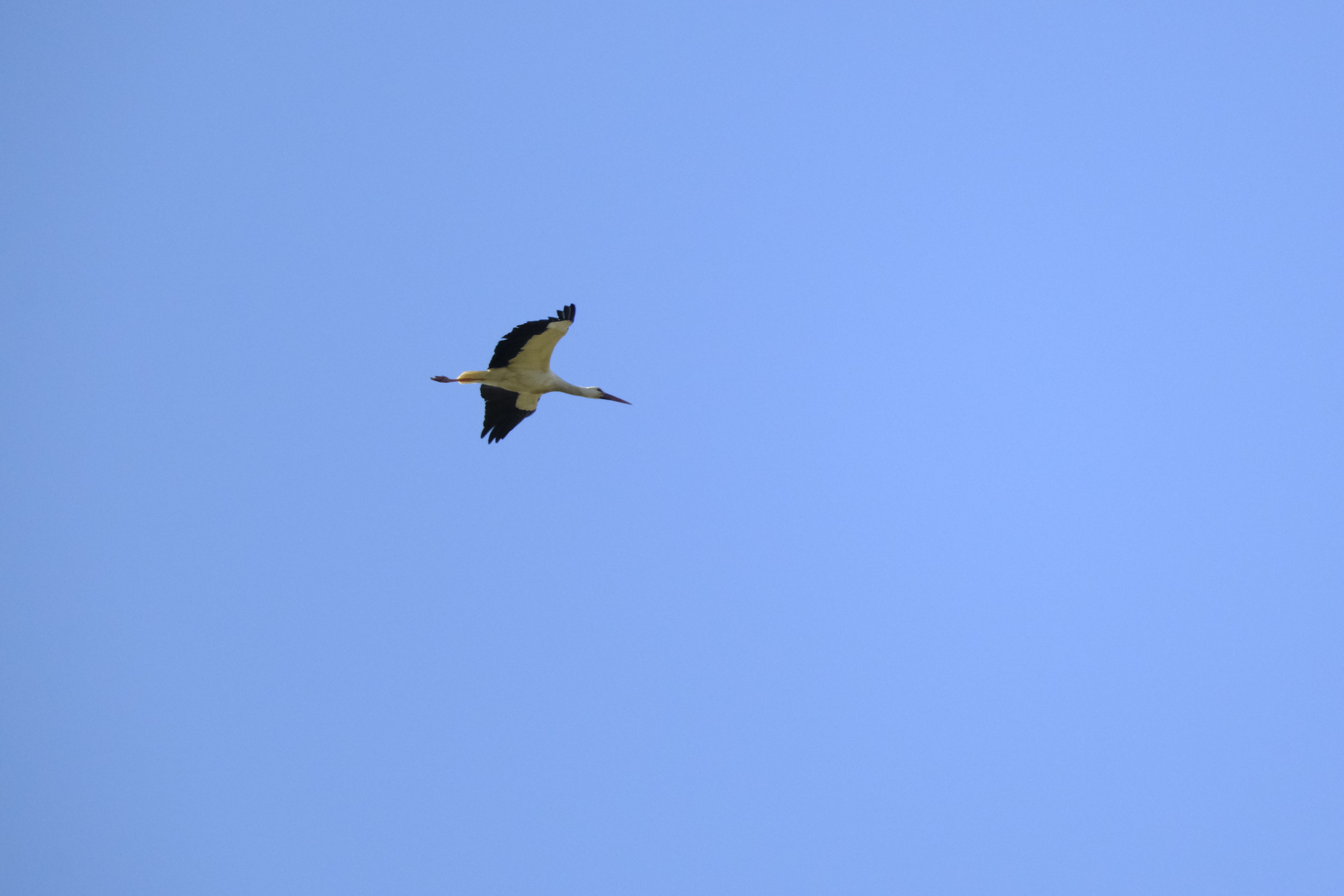Her på Skagen Fuglestations blog bringes korte nyheder i dagbogsformat om hændelser på fuglestationen.
Battle of the Towers
Today was a day we at the station have been waiting for. The Battle of the Towers. A semi-formal competition between the different Scandinavian bird observatories to do a “big sit” every year on May 3rd. The observers headed out to Worlds End 1 earlier than normal to meet Simon and Lars for the 5:00 AM start time. Meanwhile, Tue and I decided that the first hour of ringing would be too windy to justify having the nets open, so we opted to wait an hour.
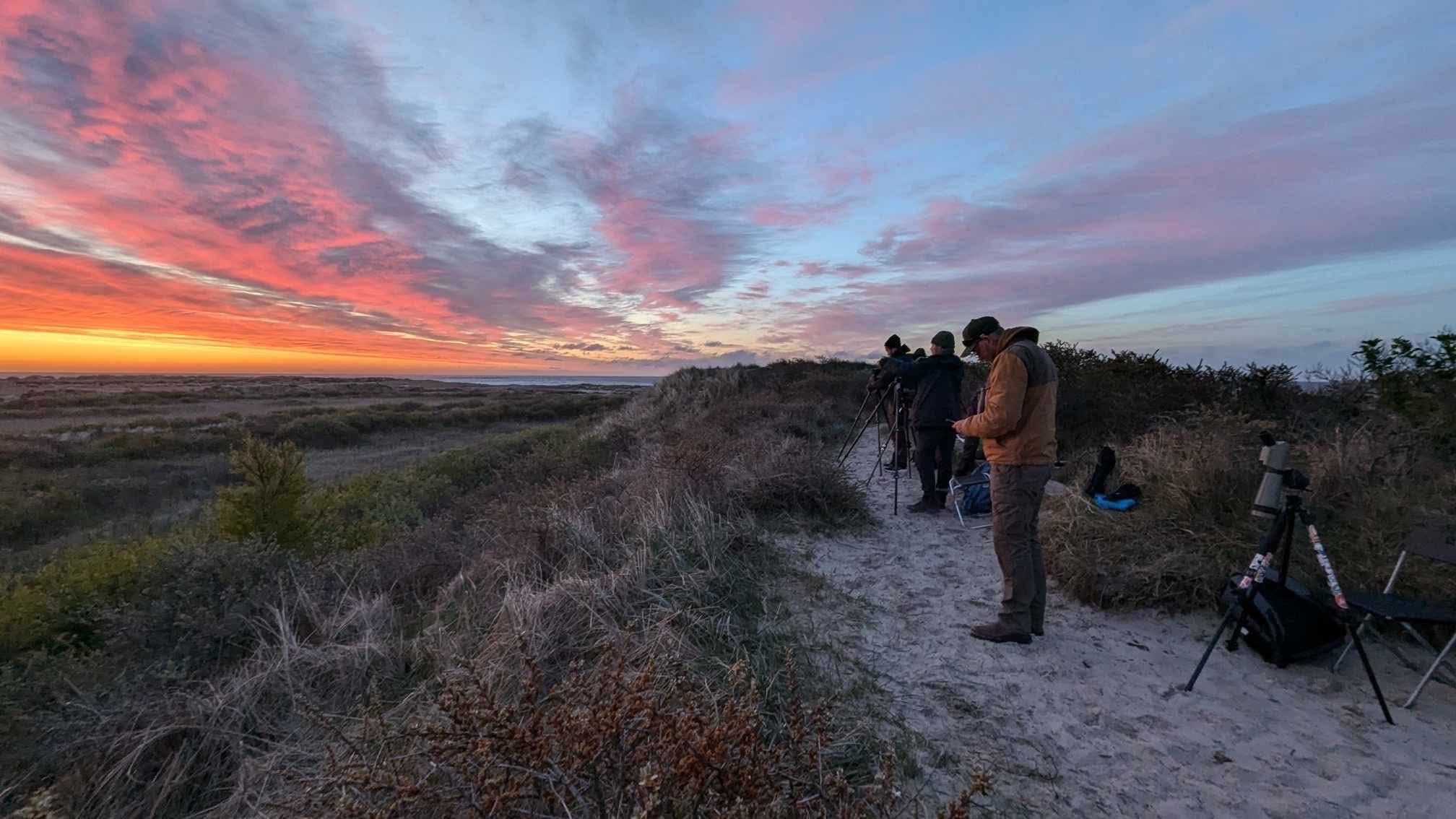
The Battle of the Tours commenced at precisely 5 AM with the first bird being a singing Reed Bunting (Rørspurv). Over the next 8 hours the observers tallied 81 species. While this is not a high count by any means, it was quite an impressive count given the extreme westerly winds. The best species of the day were Black Redstart (Husrødstjert), Peregrine Falcon (Vandrefalk) and many Fulmars (Mallemuk).
During the ringing, Tue and I had a nice relatively productive morning with decent numbers of Willow Warblers (Løvsanger) and a nice male European Bullfinch (Dompap). We were also joined by a tour group of the local college professors which Simon brought over to us.
After the ringing was complete at the nets closed, Tue and I wandered up to Worlds End to get some of the Kanelstang that Jørgen Hulbæk brought us. Thank you once again Uncle Jørgen!
Shortly thereafter; Simon, Tue and I made a quick trip down to the Sandworm track ams relocated the Flavissima Yellow Wagtail. A very nice look which got some nice looks.
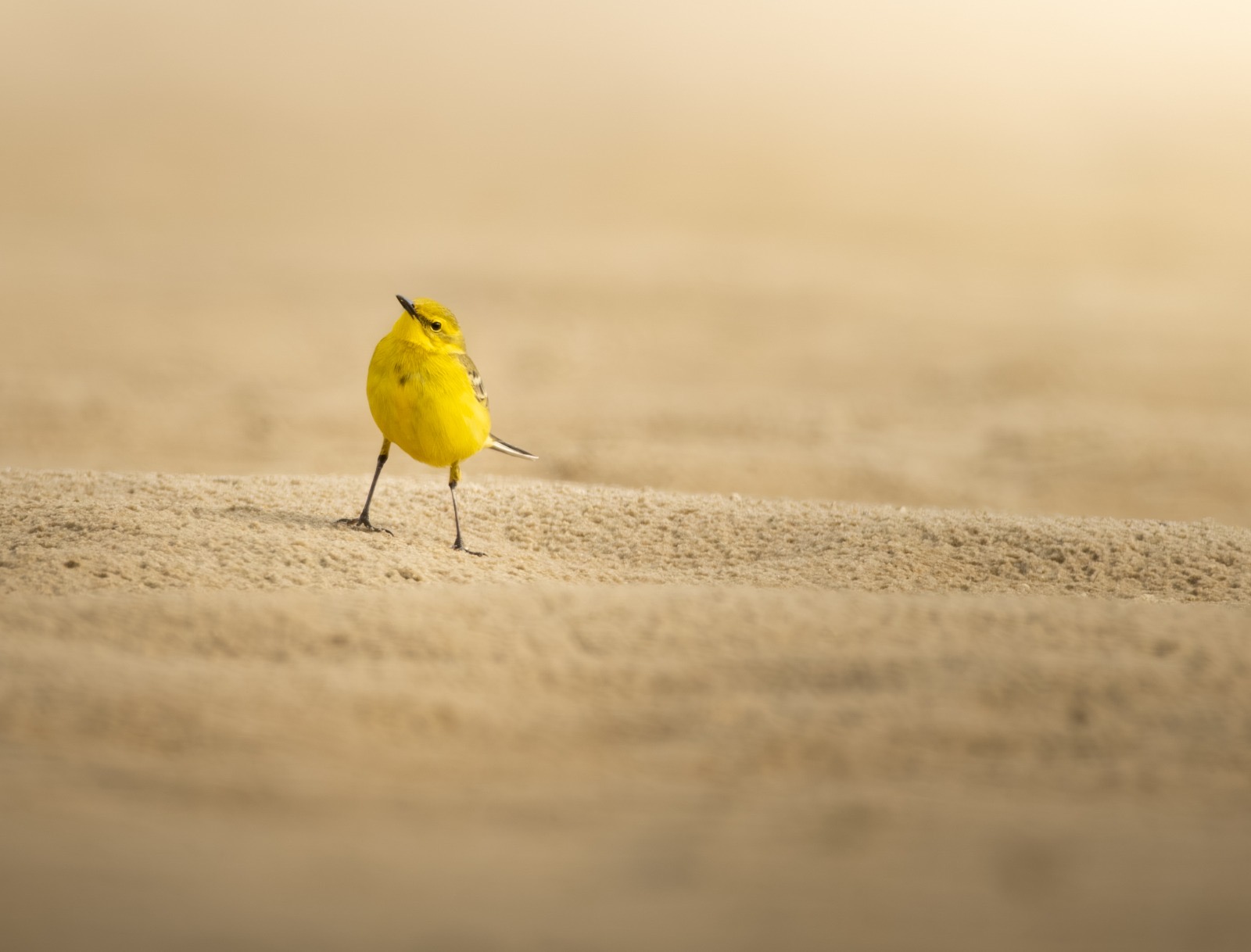
Between 5am. - 1 pm a total of 81 species were seen by the team at The Battle of the Towers. Will hopefully be enough to be in top of the competition in Denmark at least.
In the afternoon, the wind picked up drastically beyond what it was in the morning. We spent the afternoon cleaning and completing data for the last several days.
Tomorrow will be very windy and we will not be able to ring, but we look forward to our observations! You never know what you’re going to find.
And so, another day passes at Skagen Fuglestation. What will tomorrow bring? We will have to wait and see!
Highlights:
Flavissima Yellow Wagtail 1 (Gulvipstjert)
Battle of the Tours!
Ringing:
Kabeltromelen:
Rødstjert 1
Løvsanger 9
Munk 5
Dompap 1
Tornsanger 2
Total: 18
Raptor Migration in Skagen Today
Today’s observations in Dofbasen from observers in the area
People: Lucas Corneliussen, Tue Baaner, Cora Köberle, Andrew Jacobs, Olli Lilja, Simon Sigaard Christiansen, Lars Grøn, Gunnar Simonsen, Jørgen Hulbæk Christensen, Anton Kvarnbäck.
A great day for swagtails
Hej derude.
Denne morgen startede lidt anderledes end håbet, da vi vågnede til både regn og blæst. Det var jo ikke optimalt, så der var ikke andet for end at kravle under dynen igen og se tiden an. Heldigvis stoppede regnen, hvilket gjorde, at vi lige kunne nå at få de sidste timer af det daglige feltarbejde. Cora og Andrew cyklede derfor af sted på træk optælling og Lucas og ja cyklede ud for at åbne nettene. Ringmærkningen var ret stille i dag. Vi fik et par af de sædvanlige ansigter, som gærdesanger, munk og rødhals. Derudover havde vi en enkelt vindrossel, hvilket var super dejligt, da vi ikke har set en af dem ved bordet i det sidste stykke tid. Dog viste det sig, at det ikke var helt nok, at regnen havde stoppet, da vi det svære også blev nødt til at lukke nettene ret hurtigt igen grundet den kraftige vind. Det var lidt ærgerligt. Dog vendte dagen hurtigt rundt da vi fik en opringning fra Cora og Andrew der havde gode nyheder.
Træk optællingen havde også været til den stille side i dag, dog med nogle enkelte højdepunkter, da der fløj et par islom forbi. Dog havde Andrew taget et billede af, hvad han på daværende troede var en gul vipstjert, men under nærmer eftersyn af billedet kunne de hurtigt afgøre, at det var en citronvipstjert der var tale om, og så gik jagten i gang. De styrtede ned af klitten efter fuglen, og heldigvis landede den og rastede i et lille stykke tid foran dem, hvor Andrew fik et smukt billede af den fantastiske fugl. Det var også her de ringede til os, og jeg lover jer for at der ikke gik længe før der stod to meget forpustede ringmærker på stranden, for også at se fuglen. Dog havde den i mellemtiden flyttet sig, så vi brugte et par minutter på at lave en organiseret søgning, og til sidst var vi alle i stand til at se den, fantastisk oplevelse, og godt spottet Andrew!
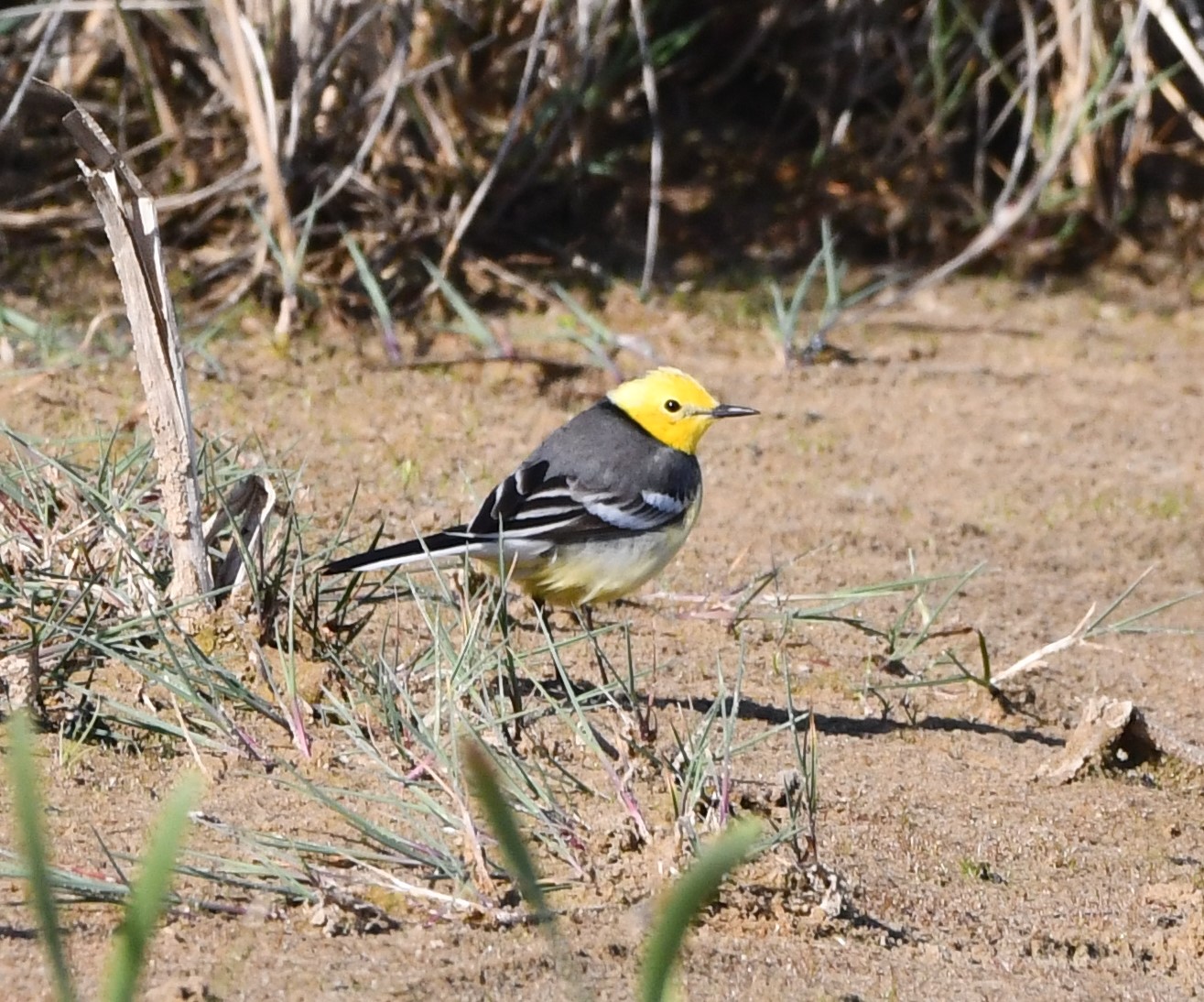
Citron vipstjert - Andrew
Med denne succes i tasken, tog vi alle hjem med højt humør. Da vi kom hjem, bagte Cora citronkage for at fejre det nye kryds på bedste maner. Efter vi havde slappet lidt af og nydt Coras køkkenkunst tog Cora, Andrew og jeg ud for at kigge efter rovfugle, Dette gav dog ikke det store, og vi måtte nok erkende, at vinden var lige til den kraftige side, både for os og fuglene. Da vi kom hjem igen, passede det med at Olli ankom, han kommer til at være ude i felten med os et par dage, så det glæder vi os meget til! ‘
Her til aften besluttede Andrew og Olli sig for at de ikke havde fået helt nok af de gule vipstjerter, så de begav sig ud igen. Med Andrews tidligere succes i tasken, var han godt forberedt, og de fandt også endnu en sjælden vipstjert, nemlig en gul vipstjert flavissima, som normalt hører til i England. En bedre måde at slutte dagen af på Findes der nok, vil jeg mene.
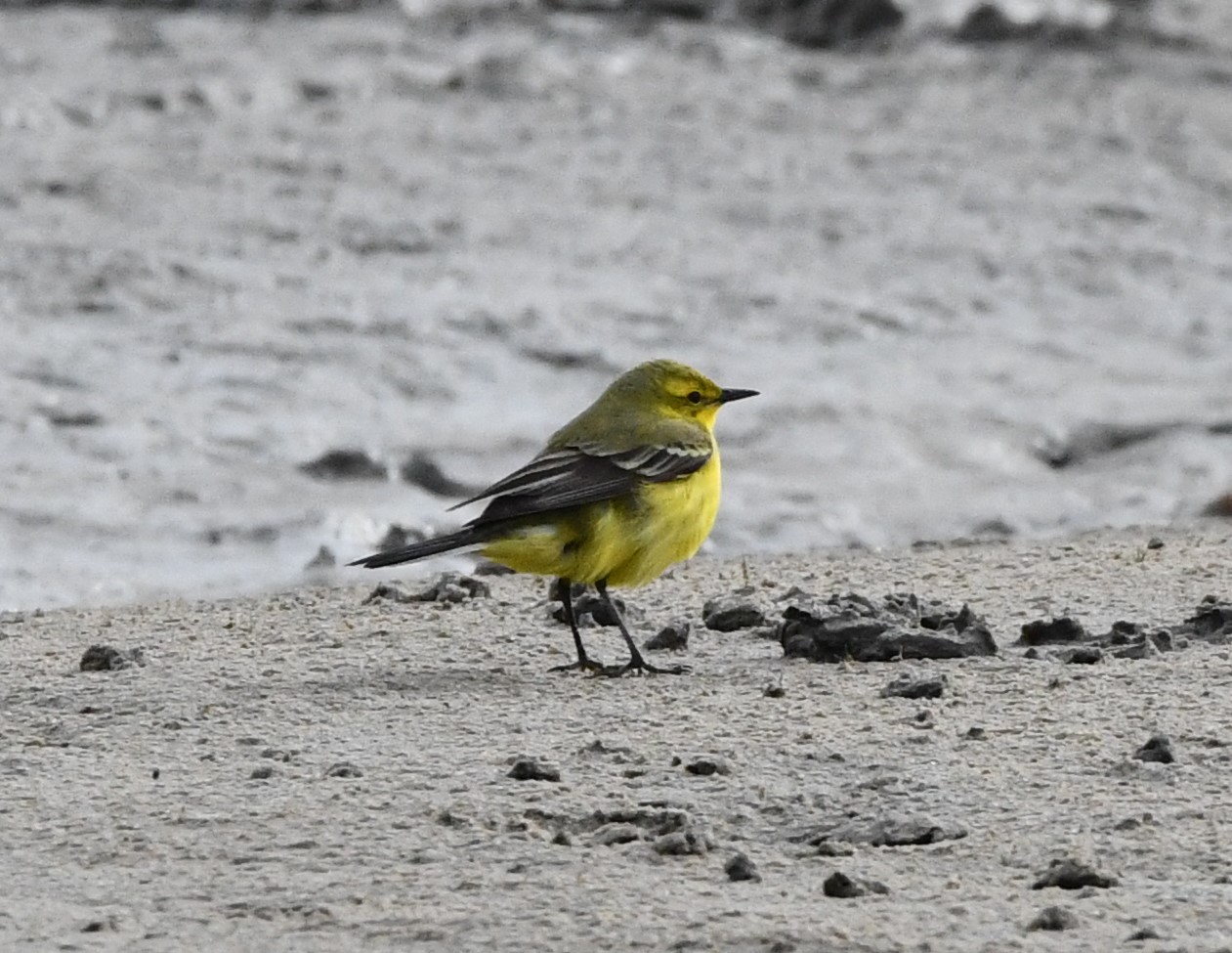
Gul vipstjert (falvissima) - Adrew
Nu må vi se hvad i morgen bringer, når vi har Battle of the Towers, som er en dag hvor en masse forskellige fugle Observationssteder dyster om hvem der kan finde flest arter. Vi regner bestemt med at hapse førstepladsen!
Vi ses derude!
Ringing (Kabeltromlen)
Rødhals 1
Gærdesanger 3
Rødstjert 1
Munk 1
Vindrossel 1
Total: 7
Observation Highlights
Sortstrubet lom 3
Citron vipstjert 1
Gul vipstjert (flavissima) 1
Raptor Summary in Skagen today
Today’s observations in Dofbasen from observers in the area
People: Lucas Corneliussen, Tue Baaner, Cora Köberle, Andrew Jacobs, Simon Sigaard Christiansen, Olli Lilja
Oriental Honey Buzzard - new species for Denmark!
Before I'll go through what happend today we will start with a story in Danish from Magnus who was the only one of us that got to experience the biggest highlight today - the Oriental Honey Buzzard:
"Mindre kunne have reddet dagen, men nuvel. Man må tage, hvad man kan få. Her er min (MHL) version af oplevelsen, berettet så objektivt som muligt. Jeg havde i sidste uge udset mig denne dag (torsdag d. 1. maj 2025), som værende den sidste dag, med morgenobs i Skagen i foråret 2025, da eksamenerne står for døren. Fredag d. 25. april ville skæbnen, at SSC ringede til mig, da han godt kunne bruge en ekstra hjælper til mogenobsen i ugen 28. april-4. maj. Jeg ville først og fremmest passe min skole, hvilket han også havde fuld forståelse for. Men vi blev enige om, at torsdag d. 1. maj vil passe os begge ganske glimrende. Vejrudsigten var på daværende tidspunkt også god for netop denne dag, da det så ud til at skulle blive den varmeste for perioden. Onsdag d. 30. april bekræftede jeg min aftale med Simon pr. telefon, selvom han mente de måske godt kunne klare skærerne uden min hjælp, da vejrudsigten på daværende tidspunkt var skiftet fra at ligne en fremragende træk dag, nogle dage forinden, så vejrudsigten nu væsentligt anderledes ud med tåge og syd-vestenvind. Jeg insisterede på at hjælpe ved morgendagens morgenobs, til trods for vejret, og aftalte at jeg skulle samle Cora Köberle op ved Det Grå Fyr kl. 05.05, og derefter fortsætte til Nordstrand, for at klare dagens morgenobs.
Om morgenen ringede vækkeuret kl. 04.05. Nu havde jeg omtrent en time til at få pakket og nå til Skagen. Google maps sagde det vil tage omtrent 39 minutter at tilbagelægge de 42,6 kilometer til Skagen, hvilket efterlod mig med 21 minutter til morgenmad og pakning. Alt lykkedes heldigvis, og jeg parkerede bilen ved Det Grå Fyr kl. 05.07, i samme nu, som Cora kom til syne i plankeværkets åbning fra haven til Det Grå Fyr. Alt var perfekt timet. Det tegnede godt.
En håndfuld minutter senere var vi på Nordstrand. Cora var glad for liftet, så hun ikke skulle endnu tidligere op, for at cykle distancen. Nu var scenen sat, og vi havde alle høje forhåbninger. Forhåbninger der varede lige indtil at vi startede morgenobsen kl. 05.20, omtrent 5-10 minutter før solopgang, og indså hvor tæt havgusen var. Jørgen Hulbæk og vist nok Jimmy Skat, var på plads omtrent samtidigt med os. Langsom kom flere kendte ansigter til, herunder blandt andet Jan Eske Schmidt og senere endnu de to lokale Erik Christophersen og Karsten Klausen (KK/Fluks), hvoraf sidstnævnte skulle vise sig at blive dagens helt.
De første timer gik på Nordstrand, og folk jokede med at de sagtens kunne have sovet længe i dag, men den havgus og relativt kraftige vind. Laila Neermann var en af dem, der tog konsekvensen af vejret, og ankom som den sidste af de birdere jeg kunne kende. Til trods for at det virkede til, at den velkendte og frygtede “prop” i den grad var sat i, var der fuld koncentration fra min side, hvilket også resulterede i at jeg fandt dagens fugl - en almindelig kjove, mørk form - der kom relativt langt ude, ligesom jeg også fandt dagens første blå kærhøg. Da morgenobsen var overstået kl. 09.20, efter de fire obligatoriske timer, begyndte jeg at fundere over hvilke “klassiske forårs-subhits”, der endnu ikke var set i Skagen i 2025, heriblandt eksempelvis citronvipstjert. Flere forlod et næsten fugletomt Nordstrand i skuffelse over dagens mavepuster på dette tidspunkt.
Cora takkede for hjælpen, og besluttede sig efter morgenobsen at tilslutte sig de øvrige fra fuglestationen ved Skarvsøen, hvor der i dag tilfældigvis var CES-mærkning. Coras beslutning skulle vise sig at blive skæbnesvangert for ikke alene hende, men flere på Nordstrand. På vejen til Skarvsøen fandt hun nemlig en vendehals, som SSC meldte ud på Zello-gruppen “Skagen Birding” kl. 09.45. Dette fik omtrent 10-15 birdere til at forlade Nordstrand, til fordel for vendehalsen. Jimmy Skat og jeg var selv i tvivl om, hvorvidt vi skulle tilslutte os folkevandringen eller ej, for at få en ny årsart. Til vores held besluttede vi at blive. Efter at have konstateret, at vendehalsen ikke længere var pp., vendte de fleste tilbage til Nordstrand, lige tids nok til at nå, hvad der egentligt skulle vise sig at blive dagens fugl. Jeg havde omkring kl. 10.00 skiftet plads fra havobs/indlandsposition, til nu at sidde i EC’s stol ved siden af KK og Hulbæk, da EC var gået ned for at se vendehals. Jeg på KK’s venstre side, og Hulbæk på KK’s højre side - kiggende mod syd. Pludselig kom der - velsagtens dagens største hul i havgusen og skydækket, hvilket resulterede i at flere rovfugle dukkede op. Heriblandt også “årets første hvepsevåge”.
Efter at have klikket, kigget og talt koncentreret i fire timer, tog jeg en times tid i “pause-mode”. Jeg kiggede ikke så intensivt efter fuglene, som i de første fire timer, men fulgte naturligvis fortsat med i, hvad der skete.
Pludselig meldte KK: “Jeg tror årets første hvepsevåge kommer her, i en skrue med musvåger.” Stort set alle på Nordstrand ville gerne se årets første hvepsevåge - til deres senere held. Efter KK’s udmelding fandt jeg hurtigt skruen på omtrent otte våger i cirka 100 meters højde, hvori især én virkede tydeligt større end de andre. Jeg var derfor hurtigt på fuglen i håndkikkert, ligesom Jimmy Skat, og vistnok også Hulbæk. Fuglen skruede et par gange, inden den fortsatte i noget der mindede om glideflugt mod ØØN. Jeg havde året forinden (2024) fået et kursus i hvepsevåger af Henrik Böhmer ved Kabeltromlen, da han allerede da var opmærksom på den østlige art. Dette kursus skulle vise sig at gøre godt et års tid senere, så derfor en tak til ham herfra.
Jeg lagde med det samme mærke til vingens bredde, mere end jeg bed mærke i fuglens størrelse og hale. En af de fire jeg stod sammen med, fik fremstammet “den ser da bredvinget ud, gør den ikke?” I samme nu slog realiteten ned i mig, om hvad det potentiel var vi havde med at gøre. KK var handlekraftig og fattede hurtigt sit kamera og fik adskillige billeder af fuglen. Hulbæk foreslog hurtigt at melde den ud på Zello som en “bredvinget hvepsevåge”, hvilket vi andre blev enige om, at han skulle. Jeg fik til opgave at følge fuglen i teleskop så længe muligt.
Hulbæk lykkedes ikke med at få Zello til at fungere, og Alex Sand Frich nåede derfor at melde den ud som den første, som den forventede “høgeørn”. Os på Nordstrand undrede os over, at høgeørnen skulle have passeret os, men konkluderede hurtigt, at der måtte være tale om samme fugl. I samme nu kom EC tilbage fra sin mislykkedes tur efter vendehals. - En meget dyr vendehals. Han fik stukket to kamera’er op i snotten af KK og Anne Marie Sloth, og nærmest afhørt af os andre, om ikke han synes det lignede en tophvepsevåge/østlig hvepsevåge (Pernis ptilorhynchus).
Erik meldte hurtigt tilbage til Alex, at han nok lige havde misset en tophvepsevåge/østlig hvepsevåge (Pernis ptilorhynchus) fra Nordstrand. Alex var noget overrasket, men tjekkede billeder, og meldte derefter tilbage, at han var enig i bestemmelsen.
Jeg tabte fuglen i varmeflimmer som den sidste fra Nordstrand i ØNØ-retning. I løbet af ti minutter kom mange af de lokale til, men da var løbet kørt. Stemningen var meget splittet på Nordstrand. Glæde, magtesløshed, skuffelse, jubel og desperation. Der var fuld plade, hvad angår følelser."
Se Karsten Klausens billeder af fuglen nedenfor.
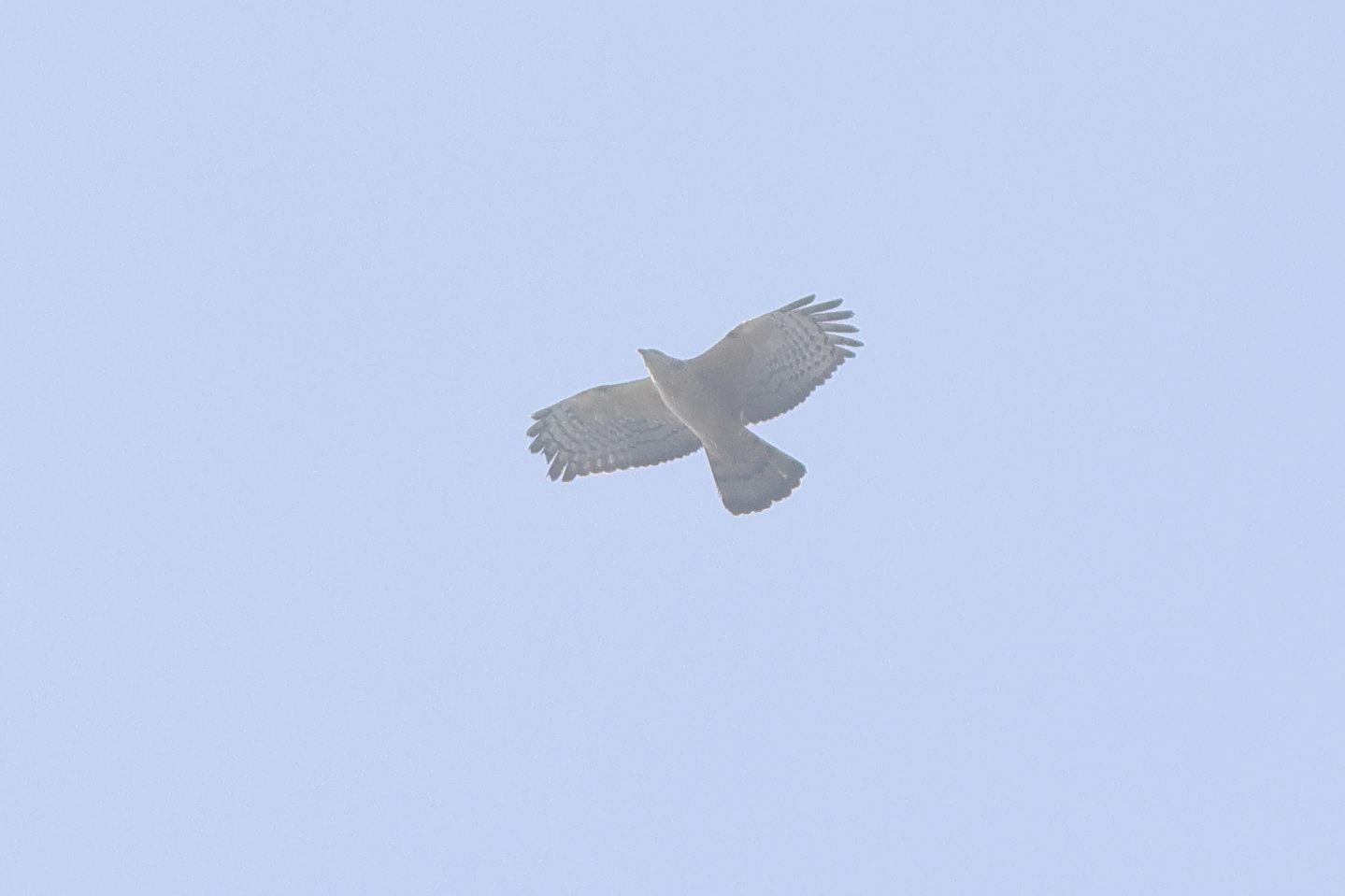
Back to what else happend today... We went for our first constant effort site monitoring project ringing at the cormorant lake Skarvsøen. The Skarvsøen nets have three areas with some nets in the reed bed, a couple on the edge of the lake and a couple in a drier marshy area allowing us to have some habitat variation for the birds we sample. We will be doing the CES ringing project around once every 10 days monitoring the breeding conditions and recently fledged offspring of the birds here throughout the season.
Today had 3 first of the season birds for our ringing with a Barn Swallow (Landsvale) as the first bird of the day setting us off to a good start. Another new bird was the Wood Warbler (Skovsanger) a very bright warbler with an extremely long wing length for its size at 80 mm indicating that it is quite the long distance migrant. The third new bird for the season was a Common Reed Warbler (Rørsanger) where we learned how to do the wing measurements to tell it from other similar looking Acrocephalus warblers. In the field around the station the Wood Warbler (Skovsanger) that we had previously ringed was calling and flitting through the bushes. The European Pied Flycatcher (Broget Fluesnapper) had places to be and seemed to migrate off to Sweden as we released it. On the lake the Great Cormorants (Skarv) were still busy adding sticks to their nests, the Red-necked Grebes (Gråstrubet Lappedykker) were dancing along the water and some Garganey (Atlingand) flew along the lake. In the swirling gull flock an interesting looking 2k bird that looked like a candidate for Great Black-backed Gull x Glaucous Gull (Svartbag x Gråmåge) hybrid was briefly on the lake with a flock of Great Black-backed Gulls (Svartbag).
Nearby Cora found an extremely camouflaged Eurasian Wryneck (Vendehals) after she ended the rather slow morning observations with Magnus. We saw the Wryneck peering through the bushes before it flitted away. It was
At the end of ringing for the day there was a commotion of trying to close nets and look for a Bonelli's Eagle that was called out on Zello. Soon after it was gone the eagle turned out to be an Oriental Honey-buzzard (Østlig Hvepsevåge)! We were looking for a big bird where we saw a flock of three raptors one with a striped tail and ran for the cameras and focused on one of the Common Buzzards (Musvåge) checking what it was and then the other two birds had gone, some of the observers at both Nordstrand and Grenen managed to spot it before as it passed and get an identification to add a new bird for both Skagen and Denmark. Of us only Magnus managed to see the Oriental Honey Buzzard since he still was at Nordstrand at that point. Simon left only 10 min. before it passed by... The bird was pointed out by both Alex Sand Frich at Grenen and at Nordstrand by Karsten Klausen simultaneusly.
Later we went to Flagbakken to watch some raptor migration where today there was a high number of Eurasian Hobbies (Lærkefalk) on migration and a handful of other raptor species moving with the bulk of the birds that were Common Buzzards (Musvåge). Then we headed back to the station to prepare for tomorrows migration spectacle.
In the evening Simon and Jørgen Hulbæk went to do some listening for norcturnal species and had at Gyvelmarkerne both a Spotted Crake (first of the year) and Tawny owl which is uncommon in Skagen.
Garganey (Atlingand) photo Andrew Jacobs
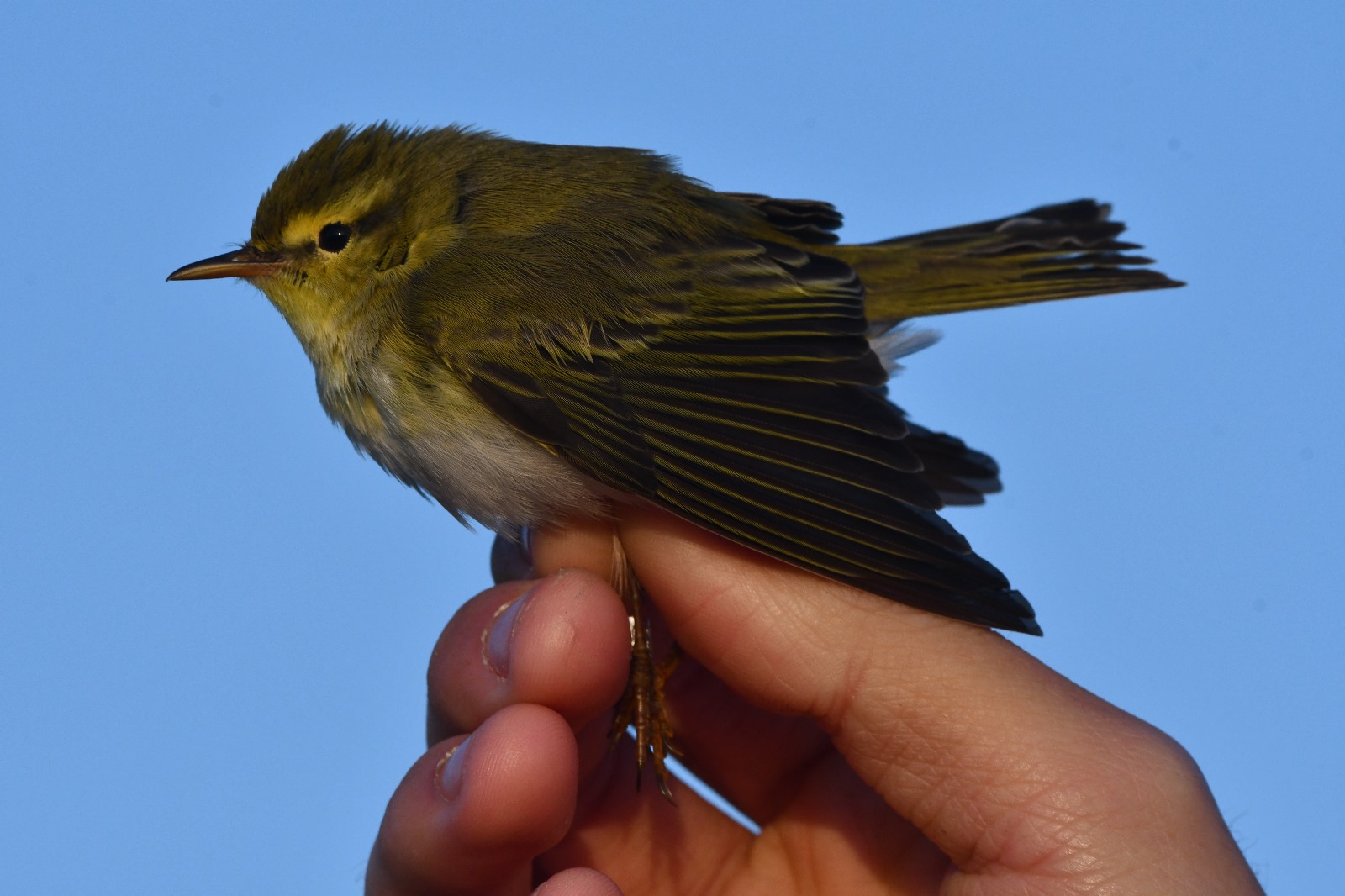
Wood Warbler (Skovsanger). Photo Andrew Jacobs
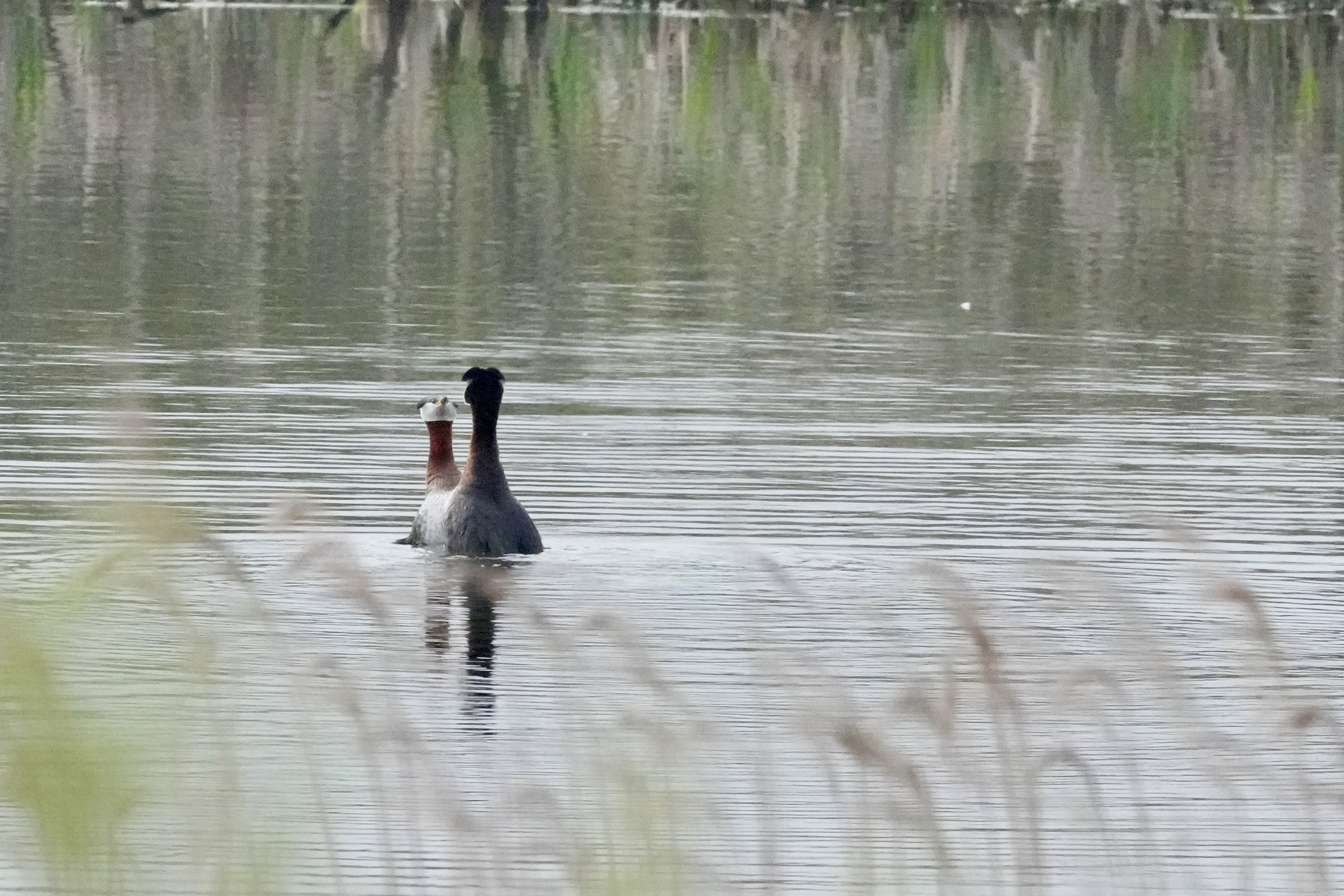
Red-necked Grebes (Gråstrubet Lappedykker) photo Søren Leth Nissen
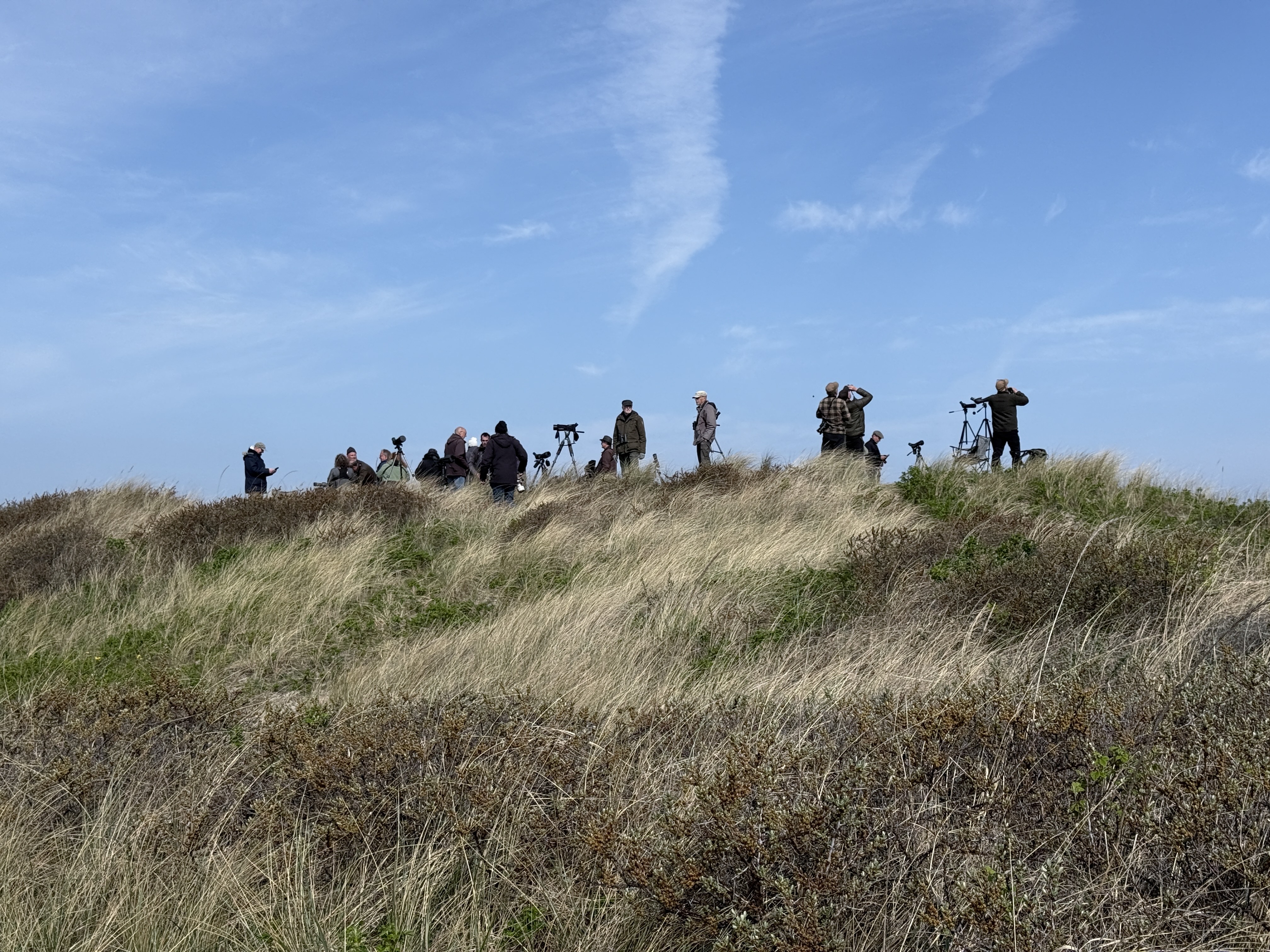
Observers looking around just after the Oriental Honey-buzzard passed. photo Søren Leth Nissen
Ringing (Skarvsøen):
Common Chiffchaff (Gransanger) 2
Barn Swallow (Landsvale) 1
Willow Warbler (Løvsanger) 4
Sedge Warbler (Sivsanger) 1
Wood Warbler (Skovsanger) 1
Common Reed Warbler (Rørsanger) 1
Common Redstart (Rødstjert) 1
European Pied Flycatcher (Broget Fluesnapper) 1
Reed Bunting (Rørspurv) 5
Eurasian Blackcap (Munk) 1
Total: 18
Highlights from the observations:
Oriental Honey-buzzard (Østlig Hvepsevåge) 1
Eurasian Wryneck (Vendenhals) 1
Garganey (Atlingand) 3
Red-necked Grebes (Gråstrubet Lappedykker) dancing 2
Putative candidate Great Black-backed Gull x Glaucous Gull Spotted Crake (Plettet Rørvagtel) 1 singing
Raptor summary for Skagen today with a new raptor
Today’s observations in Dofbasen from observers in the area
People: Lucas Corneliussen, Tue Baaner, Cora Köberle, Andrew Jacobs, Søren Leth Nissen, Simon Sigaard Christiansen, Magnus Houen Lauritsen, Jørgen Hulbæk
The Afternoon Produces!
Today started off like any other day in Skagen. We woke up early as always, as the sun is continuously getting up earlier as we progress into spring. Heading out to Kabeltromlen to open the nets, Tue and I recognized it was too windy to open the north side nuts so we in total were able to open 16 of 22. Unsurprisingly, it was a slow morning, and we caught a total of eight new birds including a nice 2k male Redstart (Rødstjert). We were also joined by one of our celebrity guests Søren Leth Nissen. Because of wind and low numbers we close in that early and headed back to the station to catch up on data and prepare ourselves for tomorrow.
In Rasmus’ absence, Cora and Andrew headed out to Grenen to do the days observations, joined by Jørgen Hulbæk Christiansen. Highlight was a White-billed Diver but also the long-staying 3k Glaucous Gull (Gråmåge) and a new ‘Viking Gull’ (Gråmåge x Sølvmåge) gave someinteresting observations. Arriving back at the station during the mid morning, one of our board members Very kindly dropped off a cake for us! Thank you!
The rest of the day was fairly slow and due to the wind we opted to have a quiet afternoon and catch up on some much-needed rest. Tomorrow we head out to Skarvsøen to open our CES nets for the first time this season and we hope for a very nice day. The weather is looking good so we are quite hopeful!
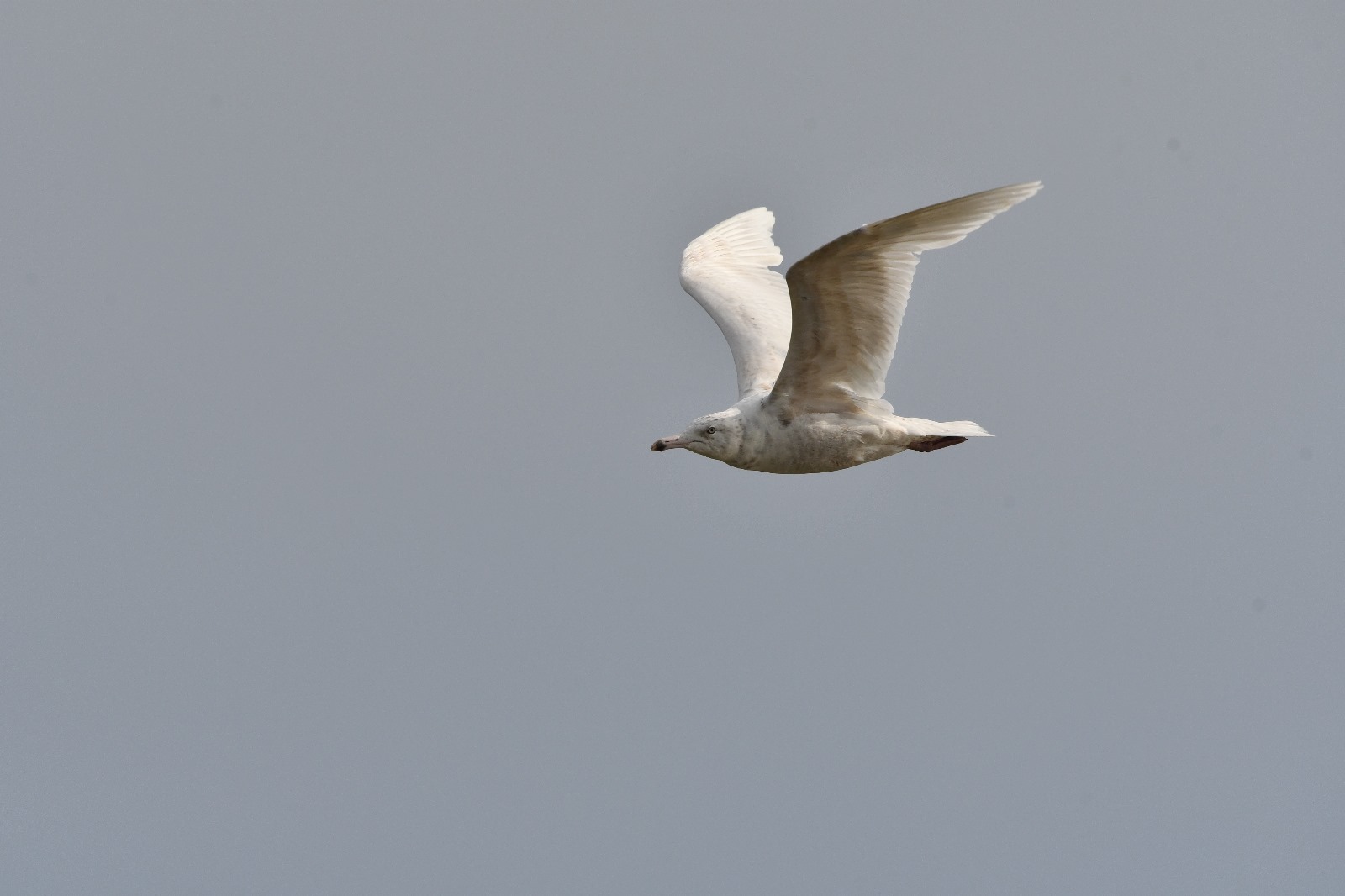 Gråmåge
Gråmåge
In the mid afternoon, the crew went with Søren to go towards town and bird in the vicinity of Batteriskoven. They had a nice walk around albeit quiet, but still managed to pull several Ring Ouzels (Ringdrossel) and a few Western Yellow Wagtails (Gulvipstjert).
Right as we were about to sit down for our evening meeting, we recieved a Zello message of a Long-eared Owl (Skovhornugle) at Batteriskoven and we quickly went down to see it before the meeting. A very nice bird enjoyed by many.
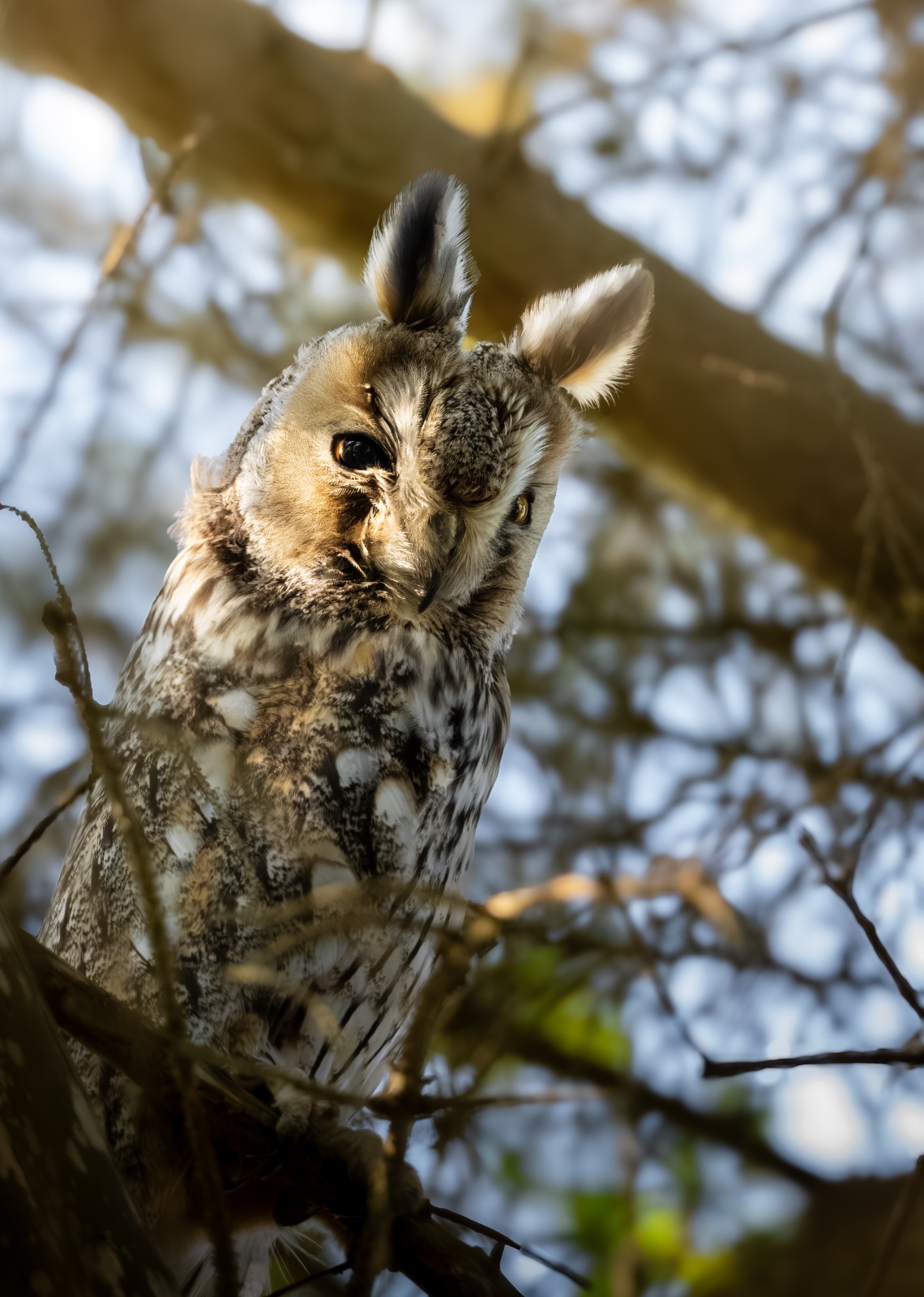 Skovhornugle
Skovhornugle
We also recieved word that one of the Common Buzzards we ringed in 2023 was resighted and photographed at Tversted. A very local bird that has stayed near the site it was captured. Nice to see a good picture of this individual and that it's doing well.
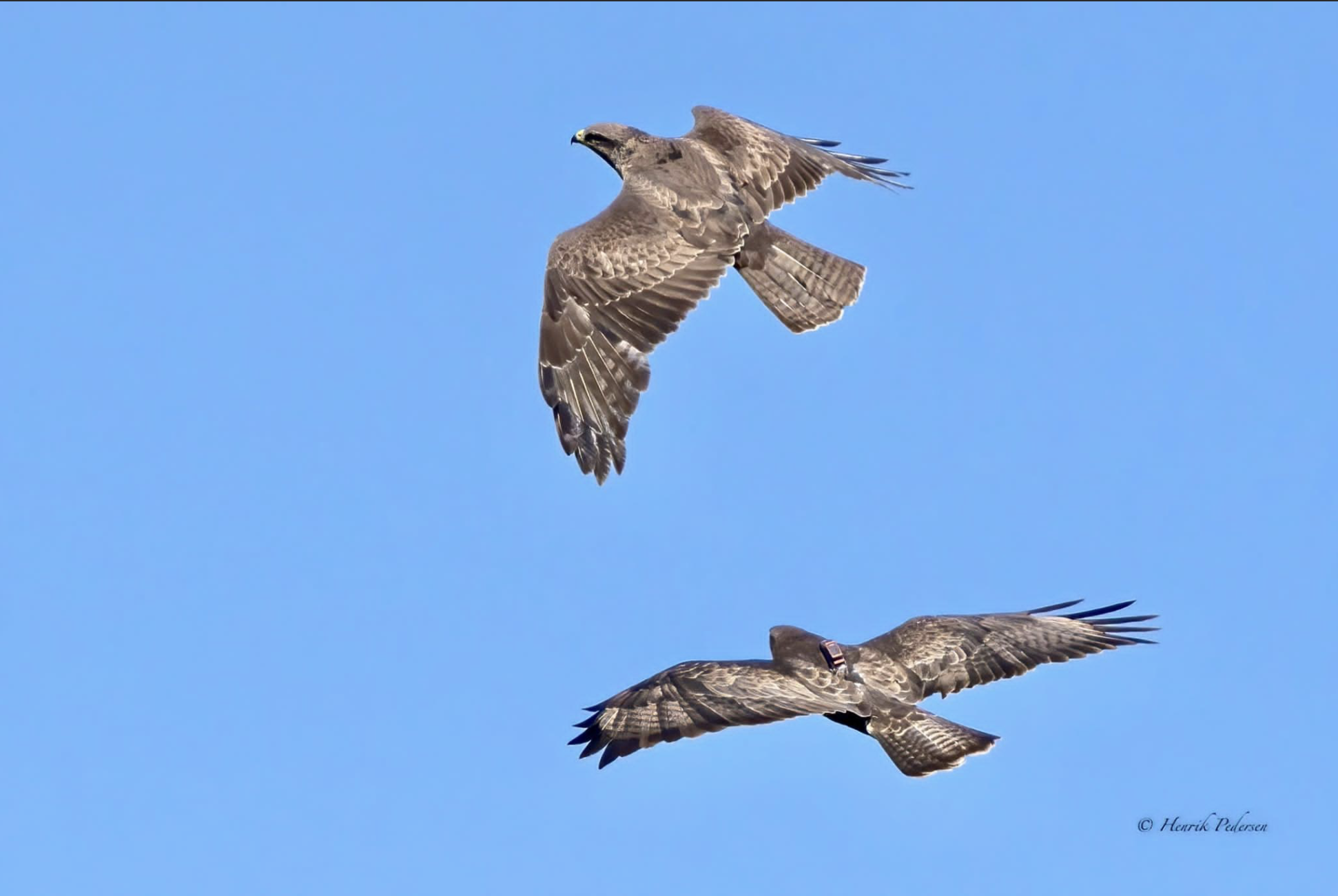 Musvåge med tracker. Foto: Henrik Pedersen
Musvåge med tracker. Foto: Henrik Pedersen
And so another day passes at Skagen Fuglestation. What will tomorrow bring? We will have to wait and see.
Highlights:
White-billed Diver 1
Gråmåge 1
Viking Gull 1
Skovhornugle 1
Ringing Data
Kabeltromelen:
Munk 1
Gransanger 2
Løvsanger 2
Bogfinke 1
Total: 6
Raptor migration in Skagen today
Today’s observations in Dofbasen from observers in the area
People: Lucas Corneliussen, Tue Baaner, Cora Köberle, Andrew Jacobs, Søren Leth Nissen, Simon Sigaard Christiansen, Niels Eriksen, Jørgen Hulbæk Christiansen
We saw the Spækhuggers again!
Today Rasmus and I were supported in counting the birds from Worlds End 3 by Jørgen Hulbæk. When we just started the counting we heard a Zello message from Simon at Kabeltrommeln. They had caught a Ring Ouzel (Ringdrossel)! So I quickly biked over to Kabeltrommeln to see this beautiful bird in hand.

Ring Ouzel (Ringdrossel) 2k Male
A bit later there was another Zello about Orcas (Spækhugger) coming just in our direction. Just a few minutes later those fantastic animals appeared right in front of us. It was really nice to observe them. Moreover we saw six Arctic Skuas (Almindelig Kjove) and also a Black-throated Diver (Sortstrubet Lom) this morning. In the last minutes of our count also the well-known 3K Glaucous Gull (Gråmage) passed by. I'm curious to see how long it will stay here in Skagen.
The ringers had not too many birds today but some interesting ones. Apart from the Ring Ouzel (Ringdrossel) I already mentioned they caught a Chiffchaff (Gransanger) which was ringed somewhere in France.
In the afternoon Andrew and I went to the Cormorant lake to check the nets at our ringing site over there so they are ready to be opened on thursday. Later we also counted the Cormorants and their nests. While we were there Simon went to the horsfields to find some nice birds. There he was surprised by three very early Bee-eaters (Biæder). He even managed to take some recordings of their calls which is very cool.
link to the recording of the Bee-eater (Biæder) calls
After he picked us up at the Cormorant lake we tried to find them again but they were already gone.
In the evening our new guest Søren arrived and also Lucas came back again.
Ringing (Kabeltromlen):
Gransanger 4
Rødhals 1
Løvsanger 2
Gærdesanger 1
Munk 2
Lille Dompap 1
Ringdrossel 1
Solsort 1
Total: 13
Highlights from the observations:
Orcas (Spækhugger) 4
Arctic Skua (Almindelig Kjove) 6
Glaucous Gull (Gråmage) 1
Bee-eater (Biæder) 3
Raptor migration in Skagen today
Today’s observations in Dofbasen from observers in the area
People: Rasmus Matthiesen-Juhl, Cora Köberle, Tue Baaner, Simon Sigaard Christiansen, Lucas Corneliussen, Andrew Jacobs, ??Jørgen Hulbæk and our guest Søren.
Ørne over Grenen
De første fugle Cora og jeg fik i kikkerten i morges var tre trækforsøgende Rørhøge, så vi fik begge to en følelse af at den her morgen kunne blive ret god på rovfuglefronten! Det endte dog desværre lidt under vores forventninger:( I løbet af morgenen frøs jeg så meget, at jeg måtte løbe to ture ude i klitterne bare for at kunne mærke mine tæer. To Mallemukker endte sammen med fire Havørne og seks Rørhøge med at blive de bedste fugle i de standardiserede timetællinger. Lige efter at vores arbejde var færdigt, så vi dog en Lille Skrigeørn og en flok på 14 Røde Glenter:) Det var fedt!
Ringmærkningsteamet bestod i dag af Andrew, Tue og Simon. De havde en god morgen med et godt flow af fugle i nettene. En flok lærerstuderende fra Hjørring kiggede også forbi Kabeltromlen, hvor de så en masse fede fugle! Bla. en Spurvehøg som Tue fangede og ringmærkede, og en flot rødstjert:) Fra Kabeltromlen blev Skrigeørnen også set af ringmærkere og lærerstuderende, og under lukkerunden ti Havørne lige så:)
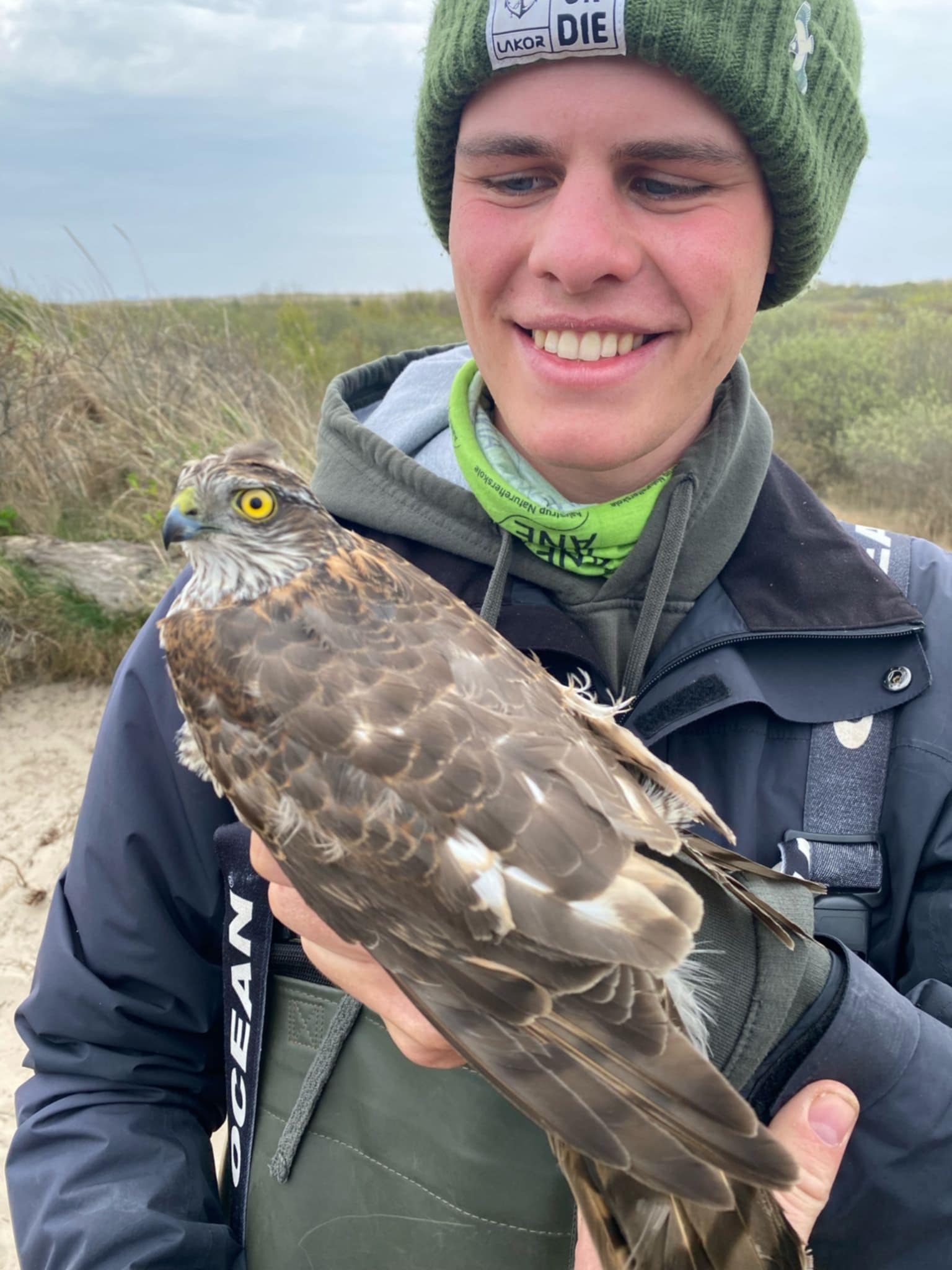
Spurvehøg med bytte
Jeg er så småt ved at pakke min taske, da jeg drager sydpå (Vrå Højskole og Aarhus) i den næste uges tid. Jeg skal nemlig spille til dette års SPOT-Festival med mit band JUVENILE på torsdag, og det glæder jeg mig meget til! Jeg har pakket tasken med 1-2 par rene underbukser, 8 trommestikker og vabelplastre, så jeg er godt dækket ind:) Og ja, den er god nok! Det er en almindelig kjove, mit band JUVENILE har som logo.
Tue laver min livret i aften, Tarteletter!! Godt nok bliver det i en vegetarisk version, men det dufter stadig virkelig dejligt! Jeg satser på ihvertfald at spise mindst 10 af dem
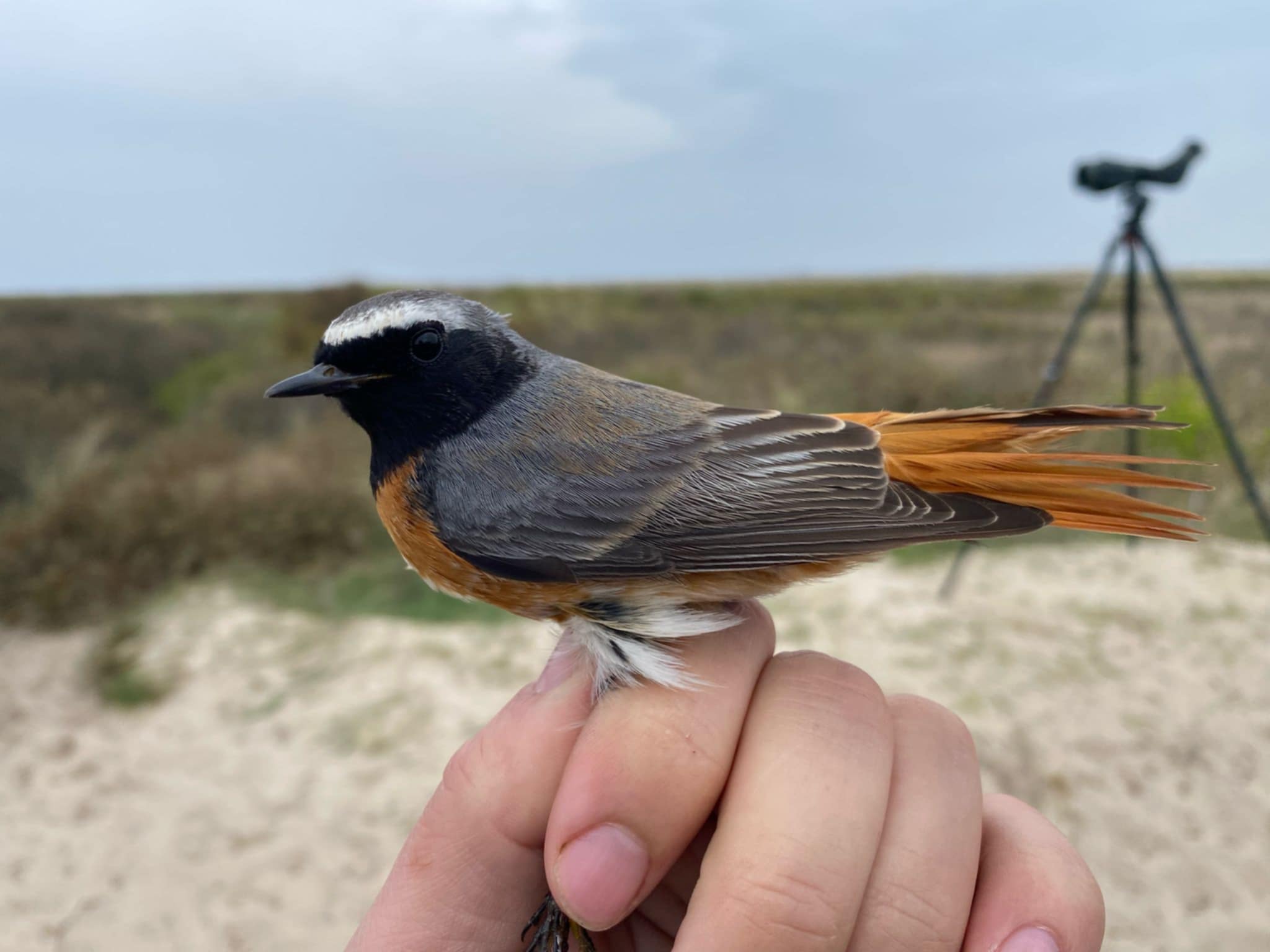
Jeg vil hoppe tilbage på værelset og få pakket færdigt, så der er kun en ting tilbage at sige:
Vi ses derude!
(på mandag, så vent lige med de helt tunge hits!) :)
Ringmærkning: Kabeltromlen
Gransanger (2)
Løvsanger (6)
Broget Fluesnapper (1)
Rødhals (1)
Rødstjert (1)
Rørspurv (1)
Munk (13)
Sangdrossel (2)
Spurvehøg (1)
Highlights fra Skagen:
Lille Skrigeørn
Raptor migration in Skagen today
Today’s observations in Dofbasen from observers in the area
People: Cora Köberle, Rasmus Matthiesen-Juhl, Tue Baaner, Andrew Jacobs, Simon Sigaard Christiansen
Ringmærkningen flyver afsted og vild rovfugleeftermiddag
Hej folkens, her får i den daglige opdatering fra Skagen Fuglestation .
I dag startede jeg dagen med ringmærkning sammen med Andrew, Oluf og Simon. I dag havde vi i modsætning til mange af dagene virkelig gang i den, og sikke en fest det var. Allerede fra morgenstunden kunne vi mærke fuglene omkring os, og det viste sig også at vi skulle få en masse fugle i løbet af dagen. Vi endte i alt med 64 fugle i nettene, så det var virkelig en glædelig overraskelse. Især munk og gærdesanger var dagens helt store hit, og begge arter fik vi store antal af. I går var det første gang i sæsonen vi fik gærdesanger i nettet, så det er vildt at se, hvor hurtigt det går, når de først ankommer. Derudover fik vi to Sivsanger, som altid er en fantastisk fugl at få lov at se tæt på. På en af runderne hørte vi også den første græshoppesanger for os, så nu krydser vi fingre for at en af dem også snart finder vej til vores ringmærkningsbord.
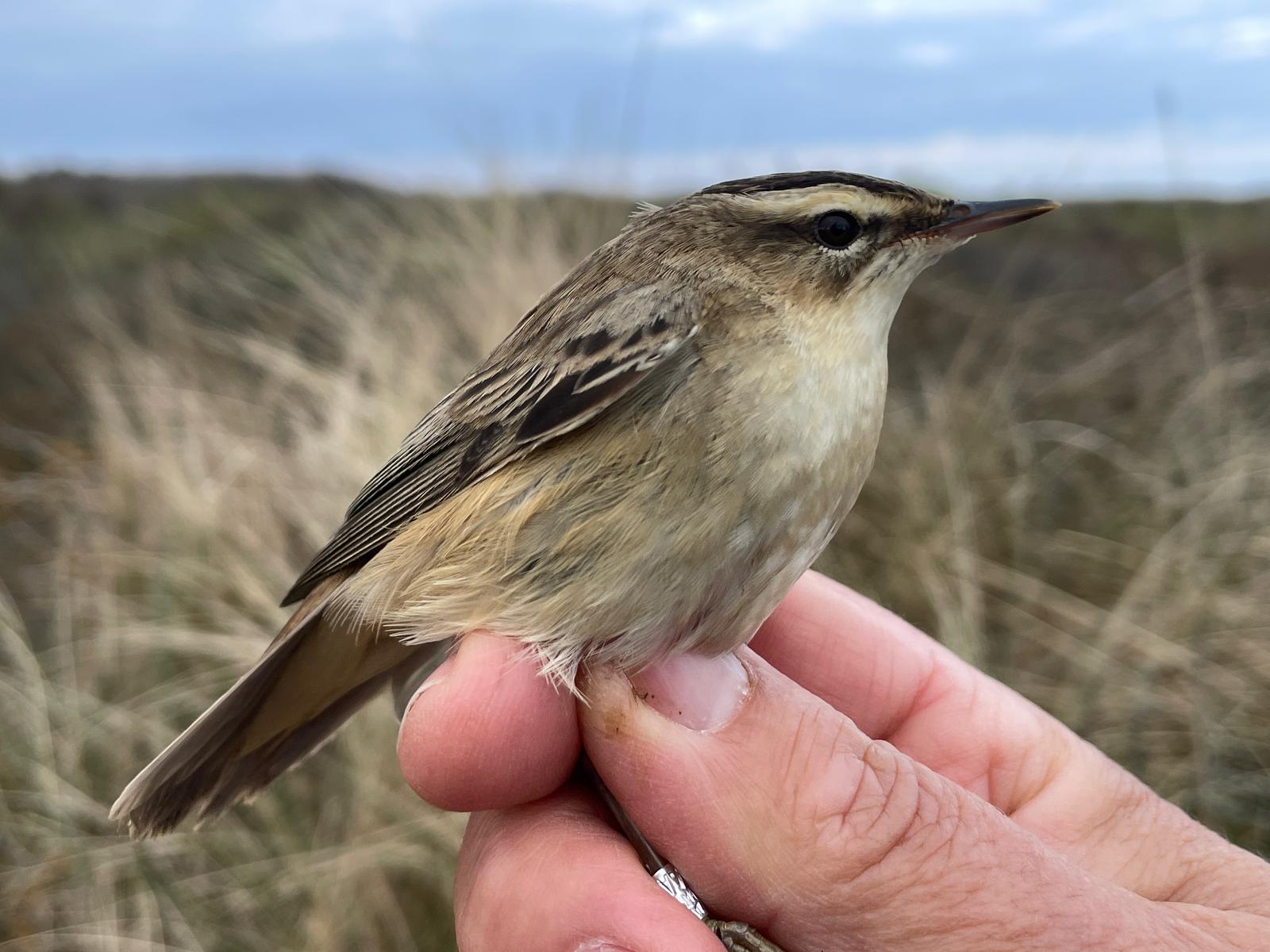
Sivsanger
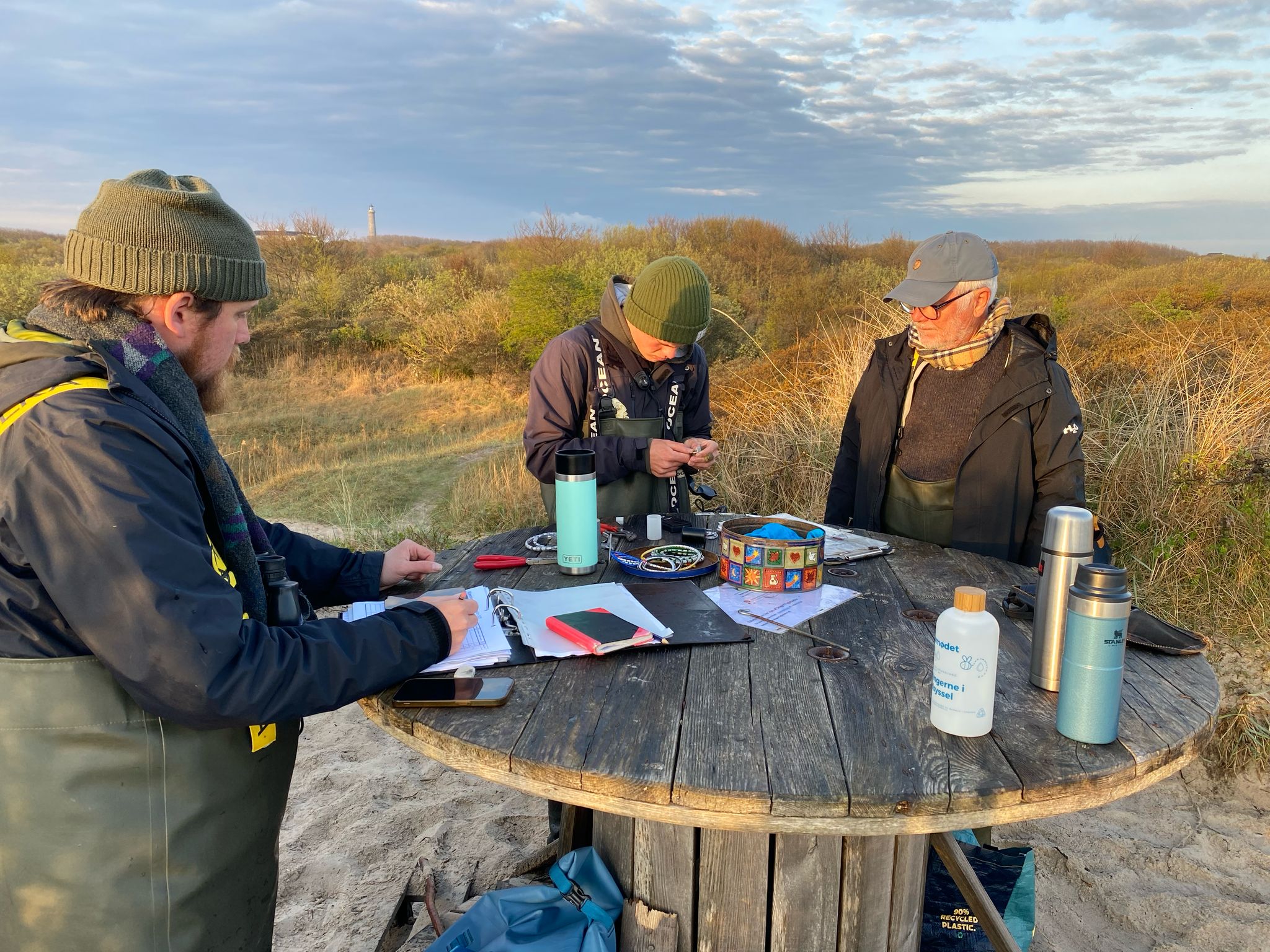
Ringmærkning
Da Cora dsv var syg idag, var det Rasmus der stod for observationerne sammen med Jørgen og Lars, som vi havde rekrutteret til at hjælpe Rasmus med at holde styr på alle fuglene. Dog skete der ikke alt for meget, hverken ude over havet eller over land. De fik dog to almindelige kjover, som kom rigtigt tæt på land. Det er altid en fantastisk fugl at se, især når de kommer tæt på.
Desværre, eller heldigvis, kom der først rigtigt gang i rovfugletrækket lige efter middag, hvor vi var taget hjem. Idag var der nemlig både set blå glente, kongeørn og to små skrigeørne syd for byen. Vi fik ikke set dem, men stort tillykke til alle dem der gjorde, nu krydser vi fingre for at de kommer tilbage i morgen. Dog var vi heldige at se en masse havørne. På et tidspunkt kunne der tælles hele 18 på samme tid. Det er altid noget der bringer et smil på læben.
Nu slutter vi dagen af med fordbodl og glæder os til i morgen til endnu en fantastisk dag. Vi ses derude.
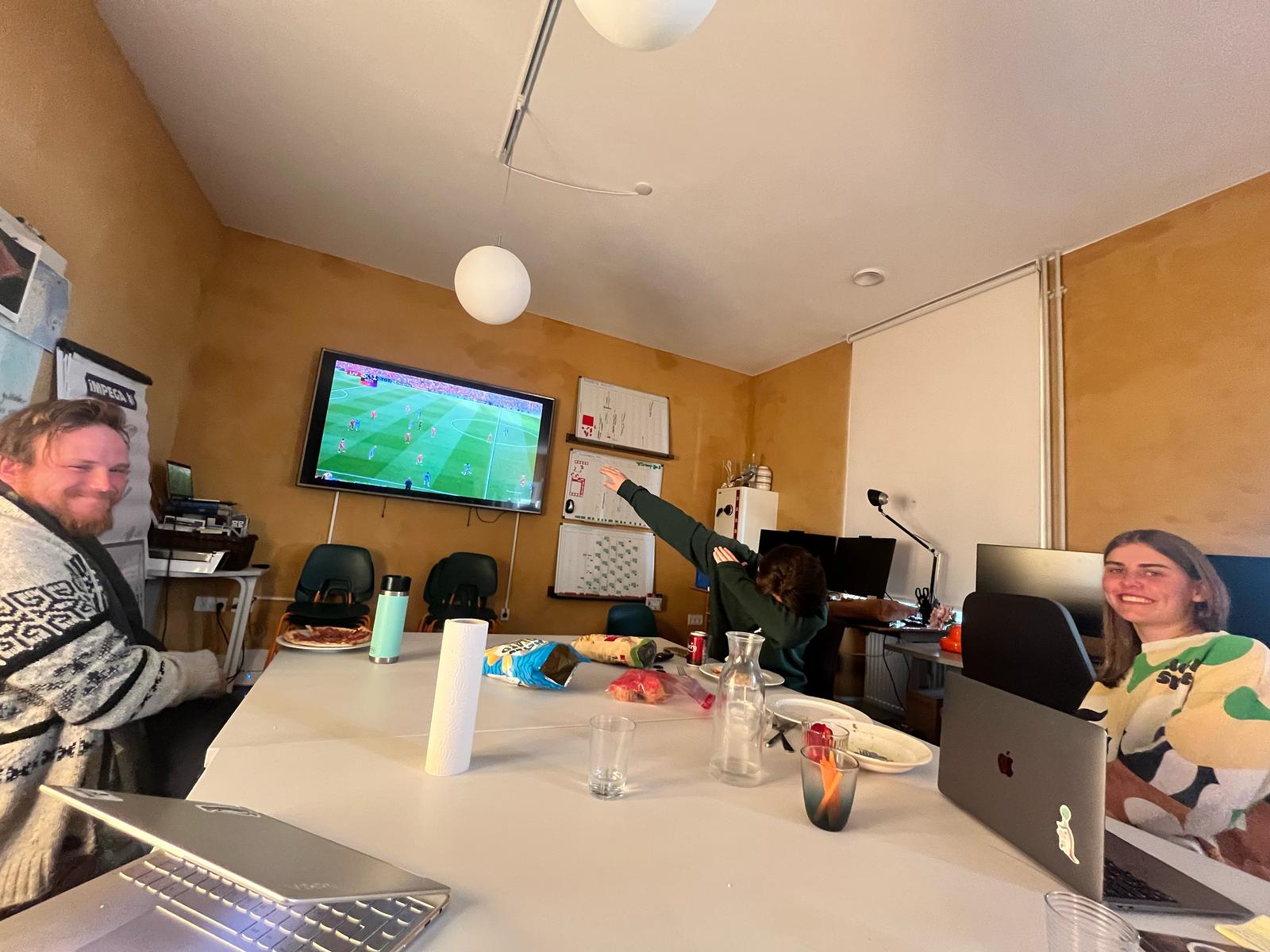
Fodboldkamp
Ringing (Kabeltromlen)
Rødhals 3
Gransanger 10
Fuglekonge 1
Gærdersmutte 1
Løvsanger 8
Rødsjert 2
Sivsanger 2
Munk 21
Rørspurv 3
Bogfinke 1
Sangdrossel 4
Gærdersanger 7
Musvit 1
Total: 64
Highlights fra dagen i Skagen
Blå Glente 1
Lille Skrigeørn 2
Kongeørn 1
Hvid Stork 2
Havørn 18
Gulhovedet Gul Vipstjert 1
Raptor Migration in Skagen today
Today’s observations in Dofbasen from observers in the area
People: Cora Köberle, Rasmus Matthiesen-Juhl, Tue Baaner, Andrew Jacobs, Simon Sigaard Christianse, Oluf Lou, Jørgen Hulbæk, Lars Paaby.
Sunshine and ringing
Today started as a chilly morning with the bikes covered in frost as we headed out for ringing. It had been a very clear night so we expected that many of the nocturnal migrants would have moved through, which seemed to be the case with most of the passerines flying over being finches including some that sounded like Parrot Crossbill (Stor Korsnæb). There were a good number of Common Wood-pigeon (Ringdue) flying overhead with a few Stock Doves (Huldue). An Osprey (Fiskørn) carried in a fish and landed to eat it before flying on off. The day became very sunny and warm, and we had been getting a good variety of birds with some Reed Buntings (Rørspurv) to practice aging them, a couple Yellowhammers (Gulspruv, the first Lesser Whitethroat (Gærdesanger) of the season and a very worn looking Common Chiffchaff (Gransanger) with rufous tones to some of its feathers. One bird today in particular Tue made a run for in the nets and got a Eurasian Jay (Skovskade), probably the best behaved jay I’ve seen ringed, it was given a steel ring for its strong bite. The Glaucous Gull (Gråmåge) continued its rounds of flying past the beach at a random moment as it has for the last while.
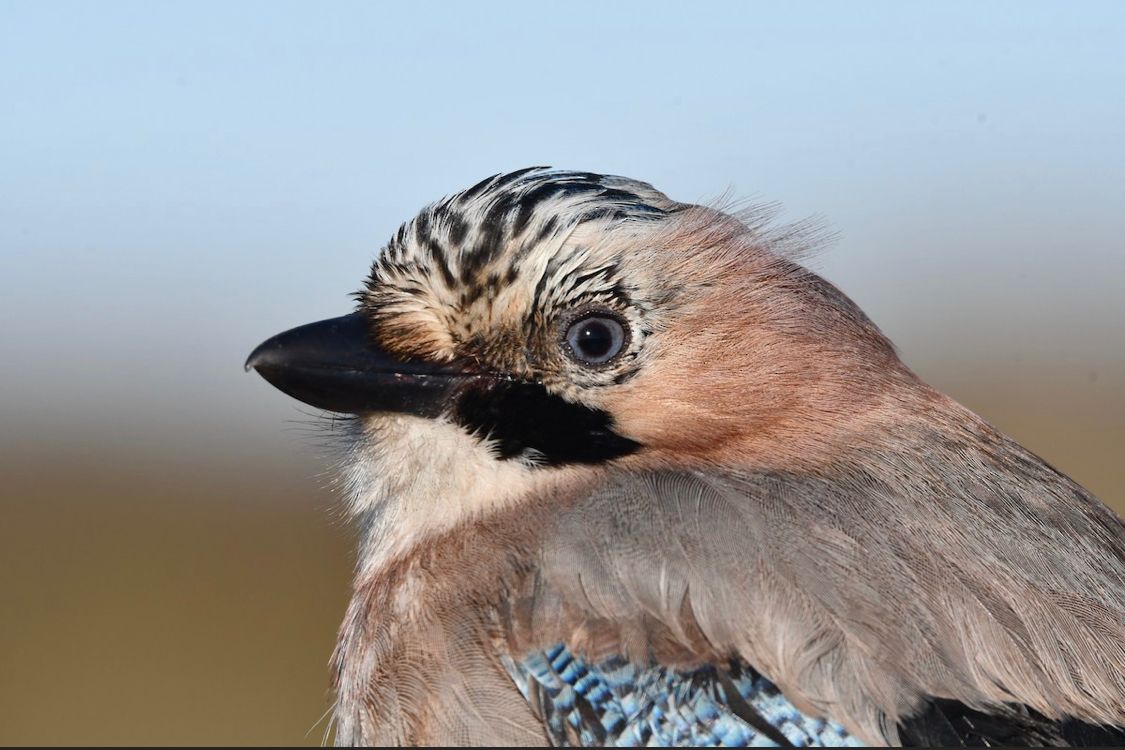
Eurasian Jay (Skovskade)
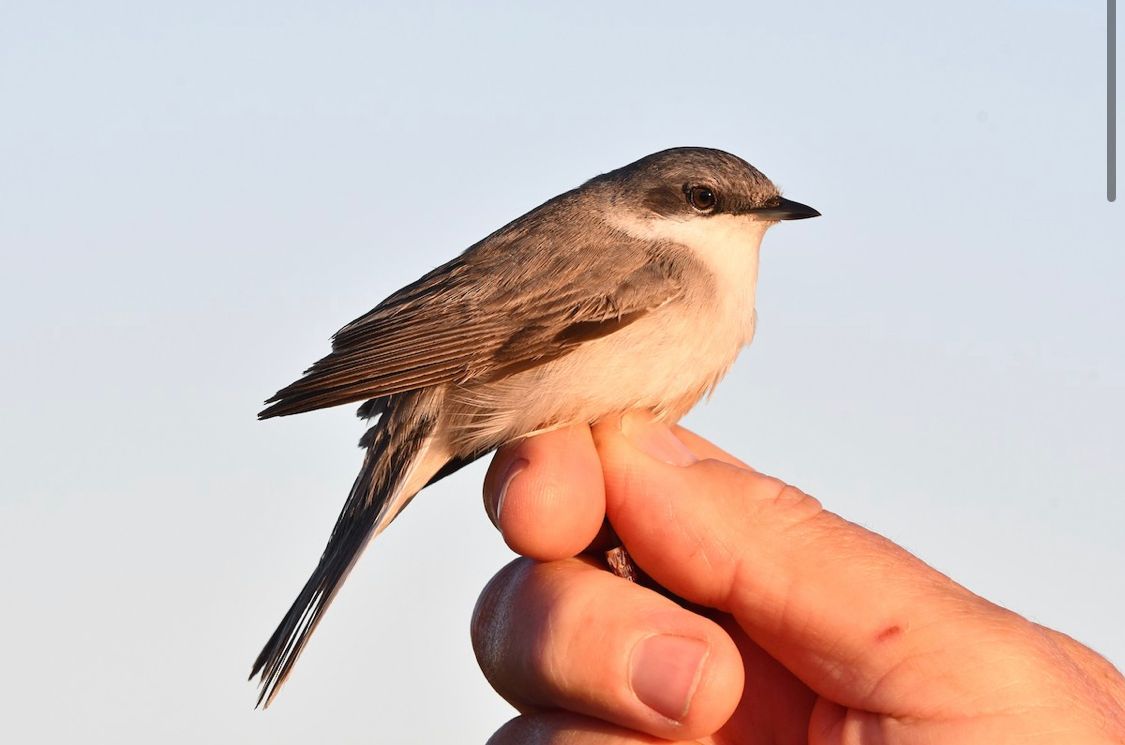
Lesser Whitethroat (Gærdersanger
The Observation team went to Nordstrand and to a raptor watching area today where they saw many good migrants a very early Common Swift (Musejler), a pair a Eurasian Spoonbills (Skestork), and high numbers of raptors.
Later in the day I went out to the waterfront by the Grey Lighthouse to look at birds flying past and some of the shallow water sea life. A Great Black-backed Gull plunge dived to catch a flounder and brought it to the beach where it quickly ate it before the other gulls noticed.
Great Black-backed Gull (Svartbag)
Ringing (Kabeltromlen):
European Robin (Rødhals) 7
Common Chiffchaff (Gransanger) 5
Yellowhammer (Gulspurv ) 2
Lesser Whitethroat (Gærdesanger) 1
Eurasian Wren (Gærdesmutte) 1
Willow Warbler (Løvsanger) 2
Common Redstart (Rødsjert) 2
Reed Bunting (Rørspurv) 2
Eurasian Jay (Skovskade) 1
Highlights from the observations:
Common Swift (Musejler) 1
Eurasian Spoonbill (Skestork) 2
White Stork (Hvid Stork) 1
Hen Harrier Blå Kærhøg) 29
Pallid Harrier (Steppehøg) 2
Peregrine Falcon (Vandrefalk) 1
Osprey (Fiskørn) 18
Black Kite (Sort Glente) 8
Glaucous Gull (Gråmåge) 1
Raptor migration in Skagen today
People: Cora Köberle, Rasmus Matthiesen-Juhl, Tue Baaner, Andrew Jacobs, Oluf Lou and Hans.
A quiet sunny day
Today Mio, Rasmus, Hans and I went out to Nortstrand to do the migration count. But there was not much migration going when we arrived there at 5:45. So we had time to enjoy the beautiful sunrise. The migration on the sea was very slow today compared to the past days. But there were many Kestrels (Tårnfalk) migrating. We had 17 of them this morning.
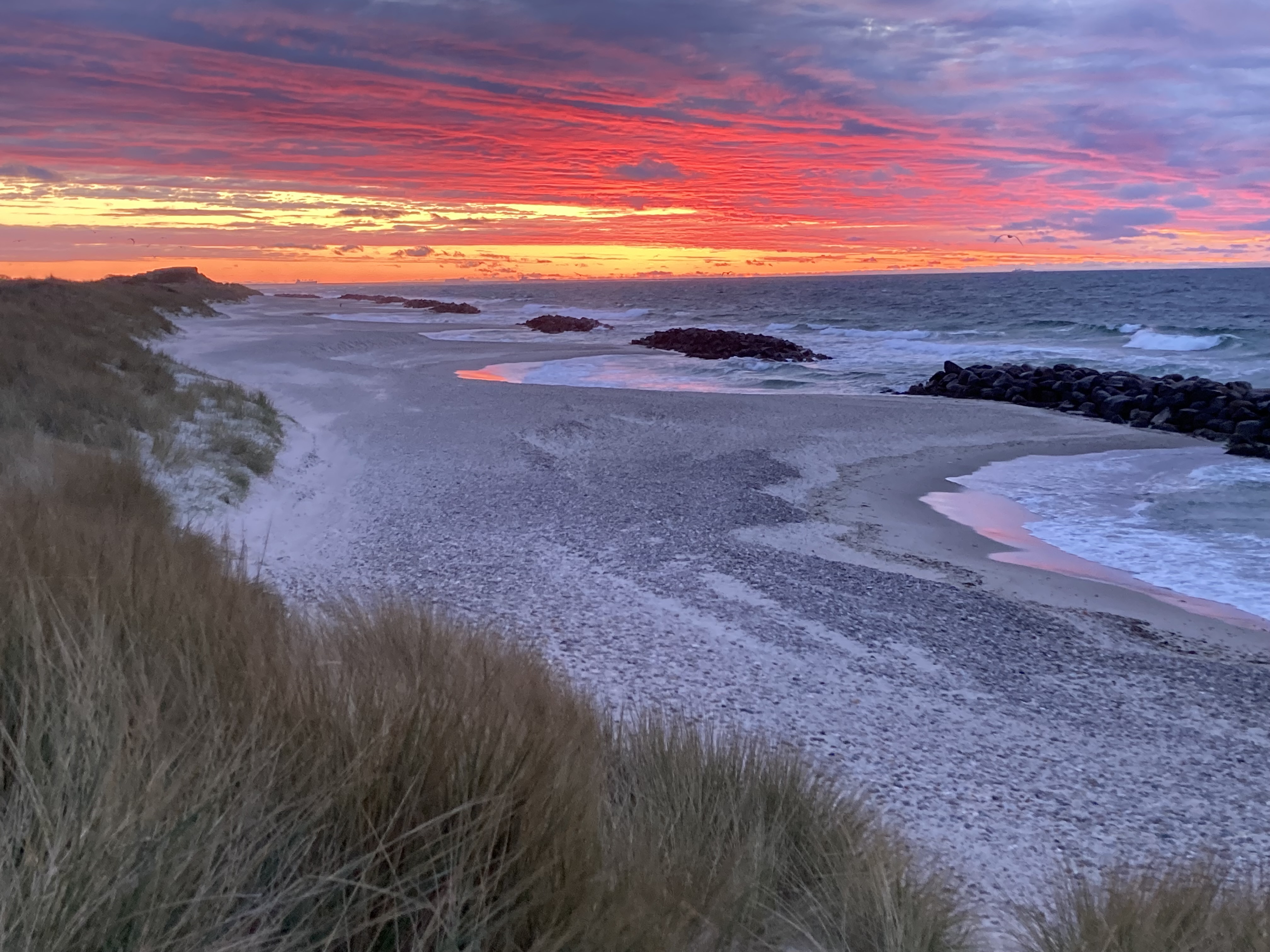
amazing sunrise
Because migration was so slow this morning Mio and Rasmus went to Skarvsøen in the third hour to count the Cormorants (Skarv). Now there are already 69 occupied nests.
Also ringing was a bit slow this morning. They rang 8 birds in total. But the ringers were still very busy because they used the time to retie all the nets and cut annoying twigs out of the netlanes. So now we have well tied and free nets again. They also had some nice birds flying over Kabeltromelen, like some nice Thrushes, some Pink-Footed Geese (Kortnæbbet Gås) and they also saw the Glaucous Gull (Gråmage) again.
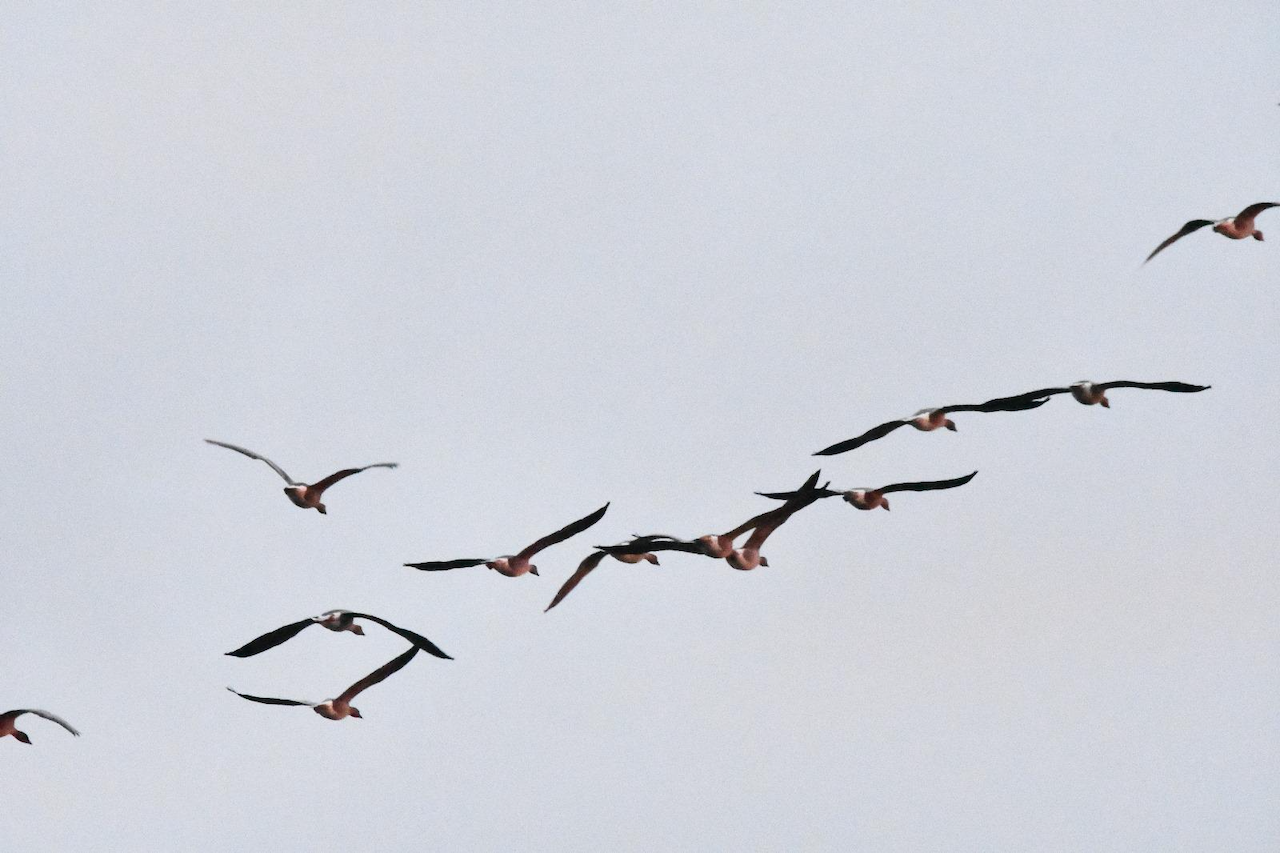
Pink-Footed Geese (Kortnæbbet Gås)
When we came back to the station Hans went out to Flagbakken again to have a nice raptor midday. The rest of us stayed back to chill a bit. But then we heard on Zello that there were some nice birds like a Woodwarbler (Skovsanger), a Wryneck (Vendehals) and two Pied Flycatchers (Broget Fluesnapper) seen in Batteryskov. So we went there and tried to find them. We could find the Wood Warbler (Skovsanger), it was also singing a bit which was very nice. Later Rasmus went out again, trying to find a Red-Rumped Swallow (Rødrygget Svale). He saw many Swallows but not the one he was looking for. But we are confident that we will find one at some point.
In the evening we unfortunately had to say goodbye to Mio because he had to go back to Berlin because the school starts on Monday again.
Ringing (Kabeltromlen):
Gransanger 3
Rødhals 3
Rørspurv 2
Total: 8
Highlights from the observations:
first Wood Warbler (Skovsanger) 1
Hen Harrier (Blå Kærhøg) 20
Kestrel (Tårnfalk) 30
Glaucous Gull (Gråmage) 1
Raptor migration in Skagen today
Today’s observations in Dofbasen from observers in the area
People: Rasmus Matthiesen-Juhl, Cora Köberle, Tue Baaner, Simon Sigaard Christiansen, Mio Brix, Lucas Corneliussen, Andrew Jacobs and our guest Hans.
En dag i ørnenes navn
Hejsa folkens Så er endnu en dag gået på Skagen Fuglestation.
I dag startede jeg morgen ud ved Kabeltromlen, hvor jeg ringmærkede, sammen med Andrew, Mio, Lucas og Lisa. Vi havde en dejlig dag, med en god mængde fugle henover hele dage. Vejret var også strålende, og da fuglene blev ved med at komme, valgte vi at holde nettene åbne en time ekstra. Det gjorde, at vi havde lidt ekstra tid til rigtigt at fordybe os i fuglene, og lære en masse omkring ringmærkningen. Virkelig en fed dag. Detsuden kom den første tornsanger forbi. Dem glæder vi også til at få mange flere af fra nu af. Derudover blev vi noget overrasket, da en spætmejse fløj hen over hovedet på os. De er langt fra en normal fugl i området, så det var en super fed observation.
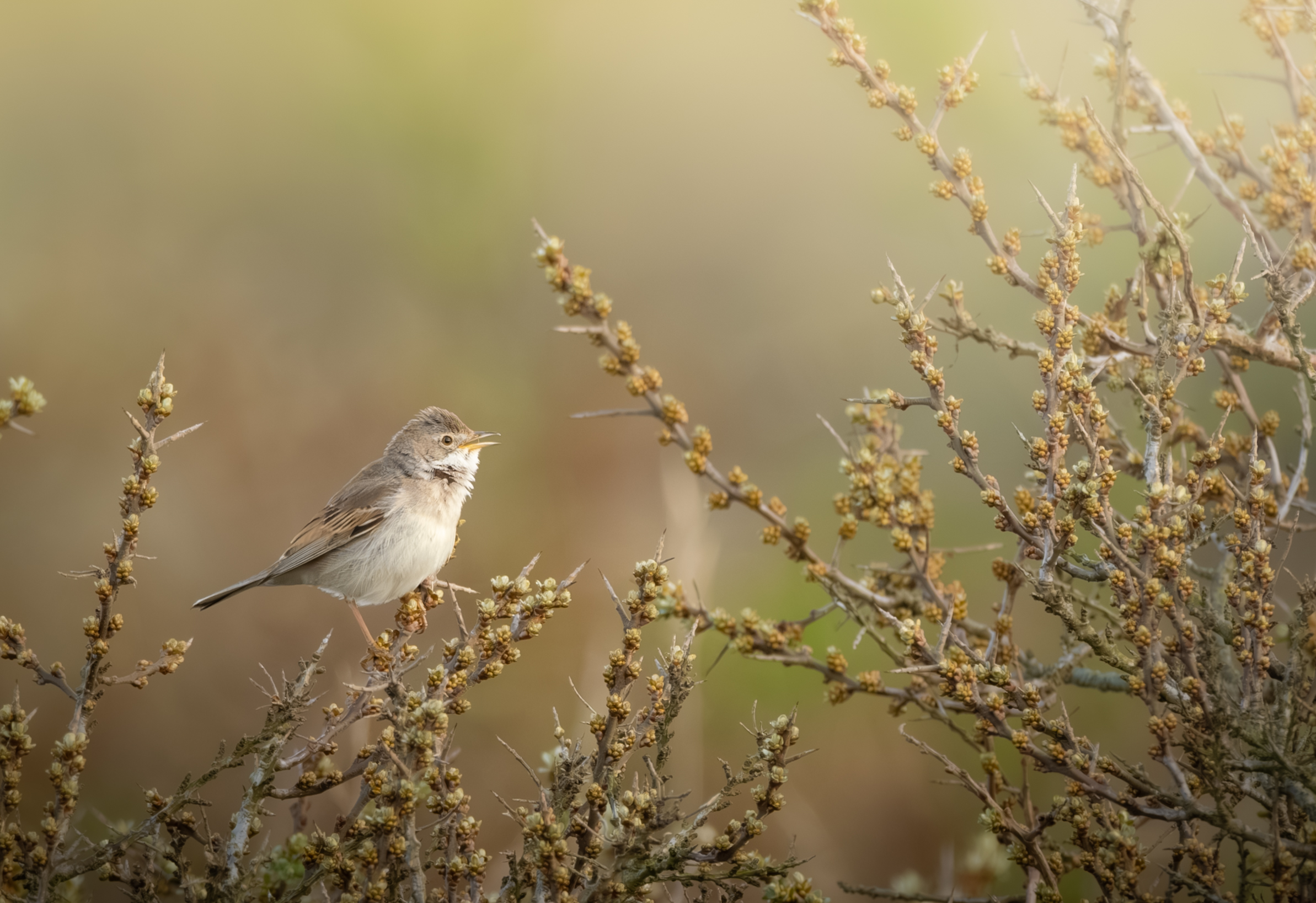
Syngende tonsanger
Også for observatørerne, som bestod af Rasmus, Cora og Hans, gik det godt i dag. De havde blandt andet et godt træk af lommer, ringdrosler og 5 kjover. Derudover var de også heldige at få både vandrefalk og mosehornugle i teleskoperne. Alt i alt en god morgen med god aktivitet.
Da observatørerne kom hjem, gik der nu ikke længe før de tog af sted igen, denne gang til flagbakken, også her var der første klasse fuglekigning, men det vender vi tilbage til om lidt. Først skal I nemlig høre om hvad der skete for os fra ringmærkningen, da vi kom tilbage til stationen. Efter at have spist blev der nemlig kaldt en dværgørn ud på Zello, som lød til at komme lige forbi fyret om få minutter. Vi styrtede derfor ud af døren, og der gik heller ikke længe, før vi fik øje på den fantastiske fugl, der lå og kredsede i en skrue med en masse våger, lige over fyret. Sikke et syn, og en fantastisk oplevelse at få lov at bruge et par minutter med fuglen, inden den fløj videre igen.
Nogen gange skal der ikke mere til end lidt held i sprøjten.
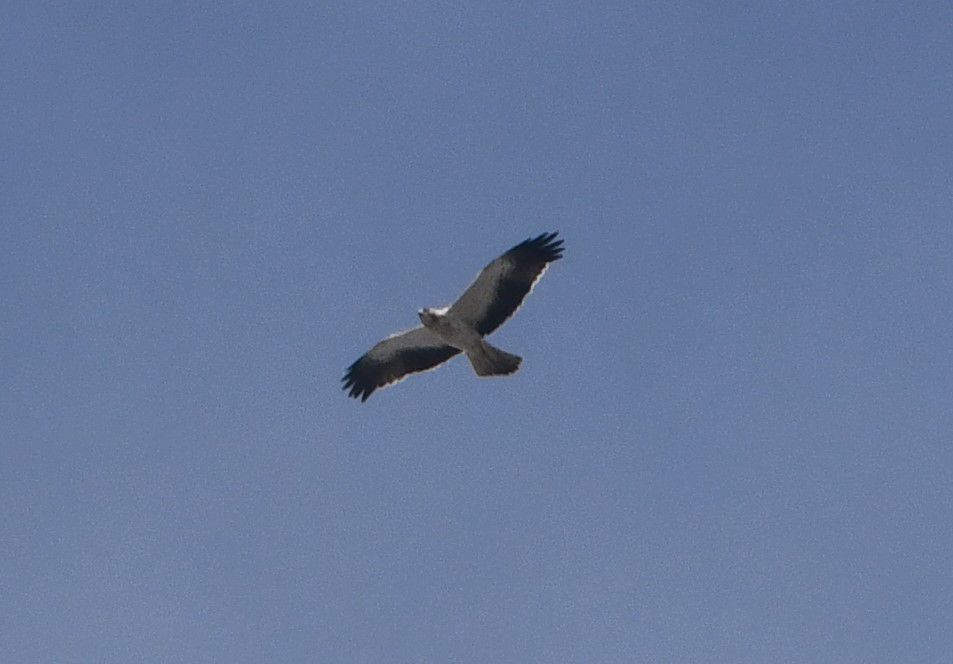
Dværgørn
Efter mødet med dværgørnen, kørte vi også af sted mod flagbakken, for at slutte os til de andre. Det viste sig at være en rigtig god idé, da der virkelig var gang i eftermiddags trækket. Der gik heller ikke længe før Mio kaldte en kongeørn ud, som han fandt cirklende med en havørn ude i skyerne. Godt spottet Mio! Derudover kom der også store antal af fiskeørne lige hen over os, og også her kom der en enkelt vandrefalk forbi. Faktisk stopper det heller ikke her, vi var nemlig også glædeligt overrasket over at se to storke, som kom flyvende mod nord. Hen mod slutningen fik vi også øje på en fin steppehøg hun, som kom flyvende forbi, sammen med en blå kærhøg og 3 fiskeørne. Godt at se at selv fuglene også går ind for diversitet!
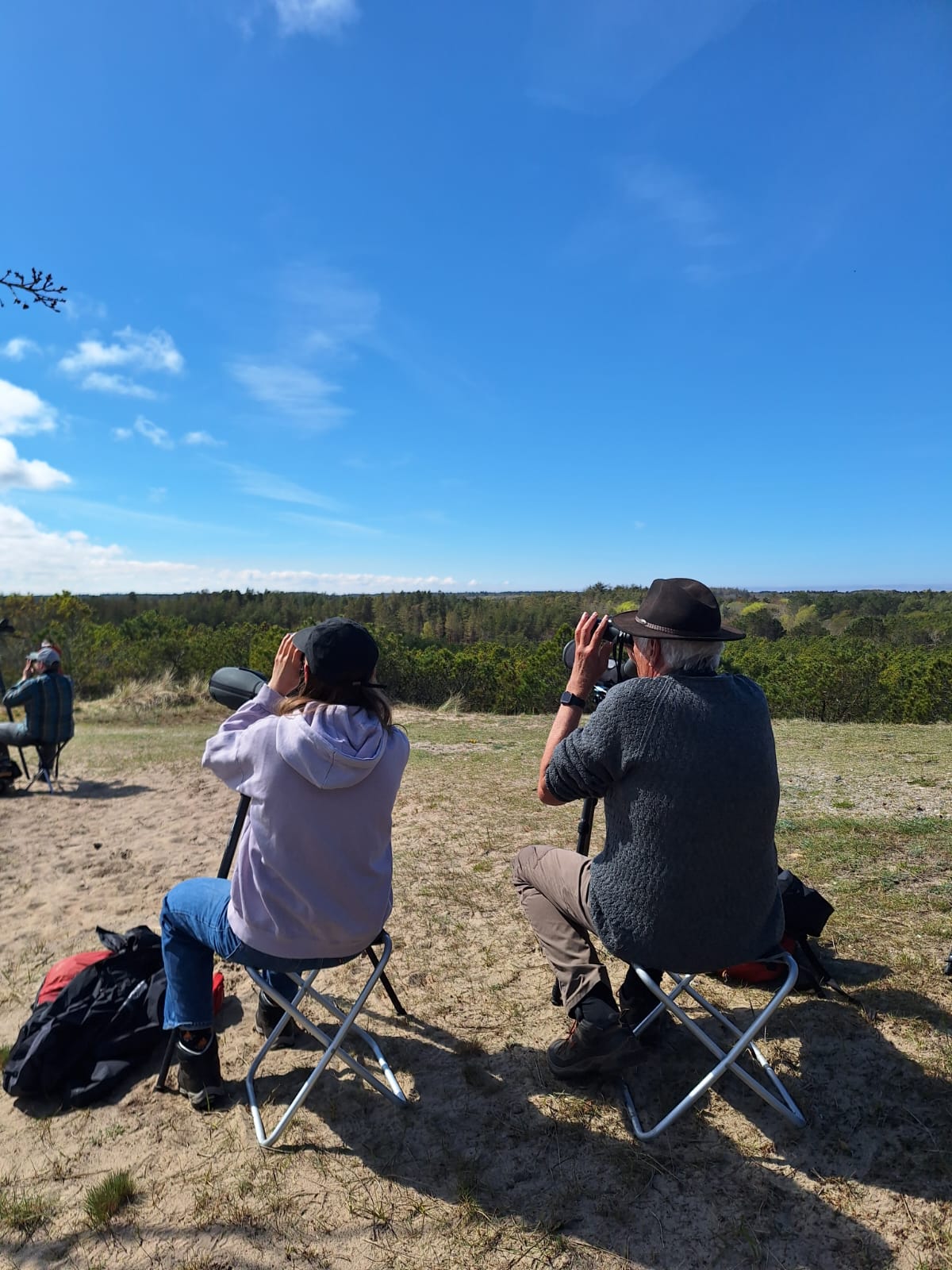
obs på flag bakken
Stork
Vi takker af efter en hel suveræn dag med hele 4 arter af ørne, og glæder os til i morgen. Vi ses derude
Ringing (Kabeltromlen)
Gransanger 5
Rødstjert 2
Rødhals 5
Gærdesmutte 2
Munk 6
Løvsanger 2
Sangdrossel 3
Jernspurv 1
Rødstjert 2
Bogfinke 2
Total: 30
Observation Highlights
Almindelig kjove 5
Vandrefalk 1
Mosehornugle 1
Observation Highlights - Det grå fyr
Dværgørn 1
Observation Highlights - Flag Bakken
Kongeørn 1
Steppehøg 3
Stork 2
Vandrefalk 1
Havørn 2
Raptor migration in Skagen today
Today’s observations in Dofbasen from observers in the area
People: Cora Köberle, Rasmus Matthiesen-Juhl, Tue Baaner, Lucas Corneliussen, Andrew Jacobs, Mio Brix, Lisa Vergin, Simon Sigaard Christiansen og vores gæster Hans og Birte.
